Northern Sounds
THE MAGAZINE OF THE DULUTH SUPERIOR SYMPHONY ORCHESTRA
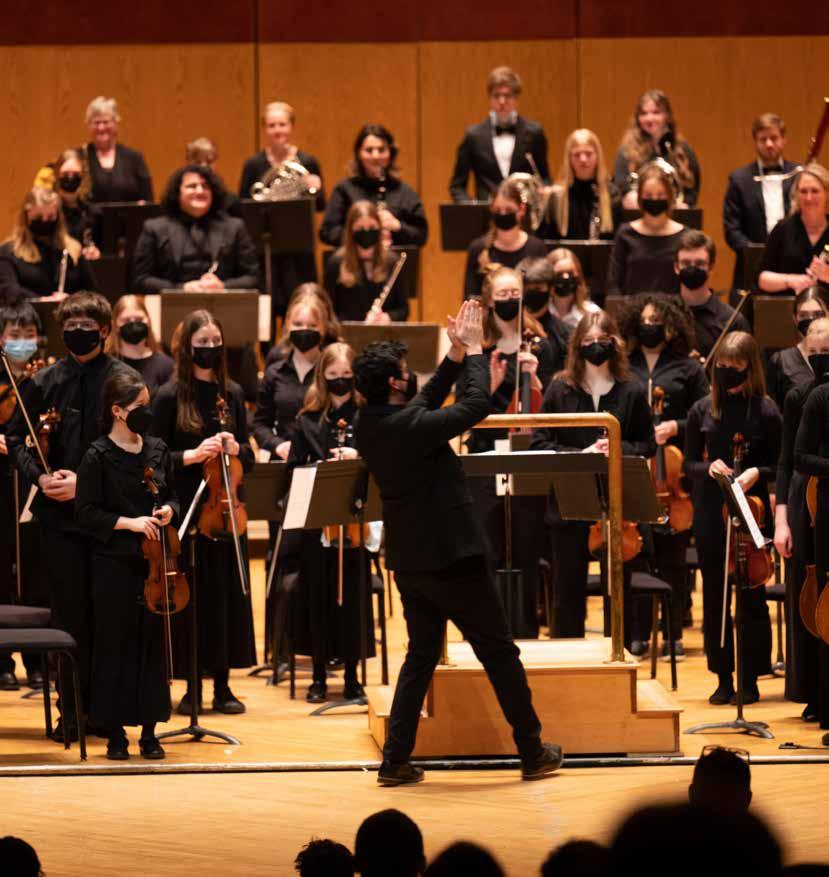
3 2022/2023 SEASON
Photos: Steven R. Mattson Zenith City Photgraphy
VOLUME
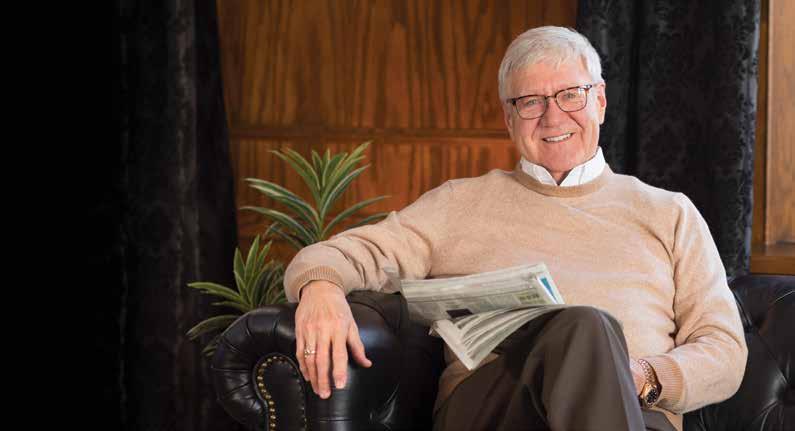
2 DULUTH SUPERIOR SYMPHONY ORCHESTRA “Is now a good time to invest?” It’s normal to have questions about investing. With 30 years of real-world experience studying mutual funds and market patterns, Curt Teberg will work to get the answers you need to help make smart decisions. Curt is just a phone call away. Ask Curt The Fund’s investment objectives, risks, charges and expenses must be considered carefully before investing. The prospectus contains this and other important information and may be obtained by calling 866-209-1964 or visiting tebergfund.com. Read it carefully before investing. Mutual fund investing involves risk; principal loss is possible. The Teberg Fund is distributed by Northern Lights Distributors, LLC, member FINRA/SIPC. 9141-NLD 04/01/2022 For information about the Fund, call Curt Teberg at 218-722-8248 or visit TebergFund.com. 5161 Miller Trunk Highway Duluth, MN 55811 TEBRX on the Nasdaq





3 DULUTH SUPERIOR SYMPHONY ORCHESTRA



Pizza
Free Delivery • Pick-Up • Dine-In • Weekend Brunch Located on the corner of Superior and Lake. Order online at duluth.pizzaluce.com FREE DELIVERY M-F: 11am-12am Sat-Sun: 10am-12am DINE-IN M-Th: 11am-11pm Friday: 11am-12am Sat: 10am-12am Sun: 10am-11pm PICK-UP M-F: 11am-11:30pm Sat-Sun: 10am-11:30pm WEEKEND BRUNCH Sat-Sun: 10am-2pm HAPPY HOUR
Lucé Duluth

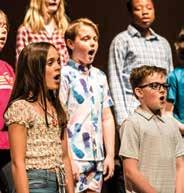
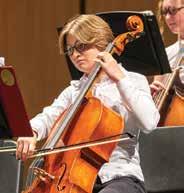

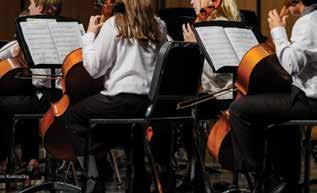
5 DULUTH SUPERIOR SYMPHONY ORCHESTRA
OUR MISSION
Our mission is to enhance our community through the performance of symphonic music that engages and inspires.
OUR VISION
We envision a stronger community through the power of music and musicians’ artistry.
6 DULUTH SUPERIOR SYMPHONY ORCHESTRA
CONTENTS DSSO 2022-23 SEASON 08 14 16 26 46 34 WELCOME LETTER 8 Music Director Dirk Meyer 9 Board of Directors 12 Staff and Administration MEET THE ORCHESTRA 14-15 Meet the Orchestra MASTERWORKS 5: GERSHWIN & RACHMININOFF 17-22 Masterworks 5 Program Notes MASTERWORKS 6: ELGAR & BRUCKNER 27-31 Masterworks 6 Program Notes MASTERWORKS 7: COPLAND & BEETHOVEN 35 Richard Robbins & Chorus Roster 36-37 Old American Songs Lyrics 38-39 Musician’s Profile 40-44 Masterworks 7 Program Notes WAYS TO SUPPORT THE DSSO 46 How to Donate 47-50 DSSO Contributors
TABLE OF

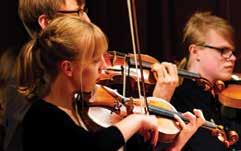

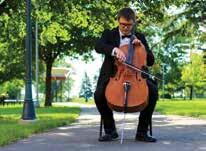
7 DULUTH SUPERIOR SYMPHONY ORCHESTRA CONTINUALLY AT THE FOREFRONT OF TECHNOLOGY 1420 London Road, Duluth | 218-728-0650 lakewalk.com Putting you in the trusted hands of an experienced surgeon, driving each procedure with heart.
Welcome to the Symphony!
This year the DSSO kicks off a three-year artistic initiative to celebrate music that is heard all too seldom. Music by composers of color, female composers, and contemporary American voices. These are composers that might be less familiar, but they certainly have important things to say!
During the 2022/23 season we will direct our focus to music by Black composers. Five of our seven Masterworks concerts include compositions by Black composers, featuring an amazing variety of music. From the contemporary voices of Adolphus Hailstork and Jessie Montgomery, to the “classics” Samuel Coleridge-Taylor, Florence Price and William Grant Still, you’ll find these compositions to be full of life, energy and beauty.
And there is even more to discover! Ever heard of Hans Rott? A student of Anton Bruckner, Gustav Mahler himself praised him as a genius and he would certainly have come to prominence, had he not passed so tragically early. How about Michael Tippett? He was one of Britain’s most prominent composers during the first half of the 20th century. His oratorio A Child of Our Time was written in support of oppressed people everywhere and makes stunning use of spirituals like Deep River and Nobody Knows The Trouble I See.
But, of course, if you are looking for something beloved and familiar, we also have that in store for you. Beethoven, Elgar, Gershwin, Sibelius, Mozart, Brahms… have your pick! And to top it off: we celebrate Sergey Rachmaninoff’s 150th birthday with two of his works: his lesser known tone poem The Rock and one of the cornerstones of the piano repertoire, his Piano Concerto No.3.
Talking about familiar: You don’t want to miss our pops performances this season. Our Holiday Spectacular is quickly becoming an annual tradition here in the Northland. And in February come enjoy the music of the most prolific film composer of our time: John Williams. You’ll hear all the classics, from Superman to Star Wars, but also rarities like his whirlwind Cowboys Overture and the jazzy Escapades based on music from Catch Me If You Can.
MEYER DIRK
So come on out and join your DSSO again this season! If you have friends who might be symphony-curious, tell them about our 9 for 90 deal: first time subscribers can purchase all nine DSSO concerts for only $90.

But most importantly, come out with family, friends, and fellow music-lovers, and have the shared experience of art and beauty once more!

8 DULUTH SUPERIOR SYMPHONY ORCHESTRA
GERMAN CONDUCTOR DIRK MEYER IS MUSIC DIRECTOR OF DULUTH SUPERIOR SYMPHONY ORCHESTRA (DSSO) IN MINNESOTA AND AUGUSTA SYMPHONY IN GEORGIA.
MUSIC DIRECTOR
Dirk Meyer, Music Director Duluth Superior Symphony Orchestra
BRANDON
VANWAEYENBERGHE
First, I am happy to celebrate three years with the orchestra. It feels like longer, due to the twists and turns that COVID has brought to our organization and the world. We have been able to manage through it all, with virtual performances and restricted numbers on stage and in the hall, to bring us back together.

BOARD OF DIRECTORS
2022-2023:
Mark Monson, Board President
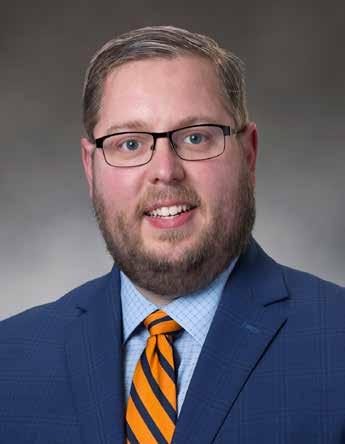
John Berchild, Past Chair
Robert T. Bennett, Treasurer
Tammy Ostrander, Secretary
BOARD OF DIRECTORS
William Alexander
Sandra Barkley
Robert T. Bennett
John Berchild
Linda Boben
Beth Gilbert
Jeremy Hoglund
Jill Kaiser
Tina Koecher
James McLeod
Michael Mollerus
Mark Monson
Emily Nygren
Tammy Ostrander
William “Buzz” Palmer
Branden Robinson
We have received so much positive feedback as we have expanded our summer programs to include regular performances at the Great Lakes Aquarium and at Fourth Fest, and more growth is in store in the coming seasons as we look to celebrate the DSSO’s Centennial in eight years.
Second, the DSSO made the conscious effort to lower prices for its 2022-23 Season. We also reshaped our ticket zones, adding 359 of our $20 tickets in the hall. And if that was not enough, we also offered the “9 for $90” subscription package for new subscribers. I am very happy to say that the community response has been nothing short of amazing. To date, the DSSO has added 337 new subscribers. If you are one of our new subscribers, thank you so much for joining us this season. We want to make sure you enjoy your concert experience, so please be in touch with me if you have any questions or anything that we can do for you.
Finally, I know that many people have read about the DSSO’s potential transition to the St. Louis County Depot. We are currently working on negotiations that will bring our offices back to the Depot building after nearly 15 years. In doing so, we will be more available to the public and also able to offer interactive displays of our nearly 100-year-old history. There are still more discussions to have, but we are excited to turn this page starting next year.
On behalf of the Board of Directors, our Musicians, our staff and volunteer Chorus, thank you so much for your support of the DSSO. Your investment – whether through purchasing a ticket or making a donation – supports our musicians and their ability to make music for the Twin Ports Community.
Kathleen Sanders
James Sebastian
Nairi Stack
Rajiv Vaidyanathan
Roberta Vose
HONORARY LIFE DIRECTORS
Elaine Killen
Dexter Larsen
Nancy Melander
James Zastrow
9 DULUTH SUPERIOR SYMPHONY ORCHESTRA
EXECUTIVE
Brandon VanWaeyenberghe, Executive Director Duluth Superior Symphony Orchestra
DIRECTOR
WELCOME TO THE 92ND SEASON OF YOUR DULUTH SUPERIOR SYMPHONY ORCHESTRA. I AM PLEASED TO BE ABLE TO SHARE SOME GOOD NEWS AND WORK OUR ORCHESTRA HAS BEEN ABLE TO ACCOMPLISH OVER THE PAST YEAR.

10 DULUTH SUPERIOR SYMPHONY ORCHESTRA Investment Products and Services Are Not FDIC Insured, Insured by any Federal Government Agency, Deposits of or Bank Guaranteed, and May Lose Value. WWW.NORTHSHORE.BANK PERSONAL BANKING | BUSINESS BANKING | MORTGAGE SERVICES | PRIVATE BANKING INVESTMENTS & TRUST | RETIREMENT SOLUTIONS | INSURANCE INVEST WITH INTEGRITY IT’S YOUR FUTURE It’s never too early to plan for the future. Call North Shore Investments & Trust at 218-722-4211 to schedule a free consultation to discuss your future and your legacy. • IRAs • 401K Rollovers • Trust & Estate Administration • Investment Management • Employee Benefit Plans • And So Much More... BANK. BORROW. INSURE. PLAN & INVEST.








11 DULUTH SUPERIOR SYMPHONY ORCHESTRA 6 DULUTH SUPERIOR SYMPHONY ORCHESTRA 2525 London Road | 218.724.1612 | www.blackwoods.com in Duluth News Tribune ‘Best Of’ Awards!
STAFF AND ADMINISTRATION:
ADMINISTRATION
Brandon VanWaeyenberghe, Executive Director
Kelly Katzmarek, Marketing Director
Jean Larson, Patron Service Manager
Ginger Dallin, Box Office Assitant
ARTISTIC STAFF
Dirk Meyer, The Charles A. & Carolyn M. Russell
Music Director
David Arnott, Manager of Orchestra Operations
Rebecca Adickes, Stage Manager
Maureen Breemeersch, Assistant Stage Manager
Kristin Sande, Music Librarian
CHORUS
Richard Robbins, Chorus Master
Nikki Norland, Chorus Adminstrator
Beth Sobczak, Rehearsal Accompanist
YOUTH ORCHESTRAS
Melanie Sever, Administrative Director and Concert Orchestra Conductor
Kristin Sande, DSSYO Administrative Assistant
Ronald Kari, Youth Orchestras Coordinator
Pedro Oviedo, Youth Symphony Conductor
Kevin Hoeschen, Sinfonia Conductor
Byron Klimek, Sinfonia Conductor
Teresa Aho, Sinfonia Conductor
Jeremy Craycraft, Percussion Ensemble Director
LAYOUT OF NORTHERN SOUNDS
Karen Blais
PRINTING OF NORTHERN SOUNDS
Pro Print
NORTHERN SOUNDS PROGRAM NOTES
Vincent Osborn, Program Notes Writer
Ronald Kari, Performance Historian, now in his 61st Season with DSSO
DULUTH SUPERIOR SYMPHONY ORCHESTRA
130 West Superior Street, LL2-120 Duluth, MN 55802
TICKETS
218–623–3776
tickets@dsso.com | www.dsso.com
MUSIC DIRECTORS
Dirk Meyer (2013 – present)
Markand Thakar (2001 – 2012)
Yong-yan Hu (1995 – 2000)
Taavo Virkhaus (1977-1994)
Joseph Hawthorne (1967-1977)
Hermann Herz (1950-1967)
Joseph Wagner (1947-1950)
Tauno Hannikainen (1942 – 1947)
Paul Lemay (1932 – 1942)
12 DULUTH SUPERIOR SYMPHONY ORCHESTRA
STAFF & ADMINISTRATION
Proud to Support DSSO
Shops
A Place For Fido
Duluth Kitchen Co.
Fitger’s Brewhouse Beer Store
Fitger’s Wine Cellars
Gourmet Market
Lotus on the Lake
The Bookstore at Fitger’s
The Snow Goose
Trail tters
Whimsy
Restaurants
Fitger’s Brewhouse
Mexico Lindo
The Boat Club
Nightclubs
The Barrel Room
Rex Bar Services
Fitger’s Salon & Spa
Duluth’s Historic Fitger’s Inn ~ Proud sponsors of the featured artist!
* FREE covered parking with validation!

MEET THE ORCHESTRA
DIRK MEYER, THE CHARLES A. & CAROLYN M. RUSSELL MUSIC DIRECTOR
Sponsors: Harris & Diane Balko; Elisabeth C. Mason; The Charles A. & Carolyn M. Russell Foundation
FIRST VIOLIN:
Erin Aldridge, Concertmaster
Sponsor: Arend & Verna Sandbulte in support of the concertmaster chair through the Sandbulte Orchestra Leadership Fund
Mary Alice Hutton, Associate Concertmaster
Angela Waterman-Hanson, Assistant Concertmaster
Nicole Craycraft (On Leave 22-23)
Sponsor: Glen Holt
Kathleen Sanders
Sponsor: Terry & Vicki Anderson
Nairi Stack
Sponsor: Stack Brothers Mechanical Contractors and Bill Stack
Joan Halquist
Sponsor: Anonymous Friend of the DSSO
Amanda Wirta
Sponsor: Anonymous Friend of the DSSO
Daniel Radosevich
Sponsor: Anonymous Friend of the DSSO
Steve Highland
Sponsor: Thomas & Barbara Elliott
Jenna Mattson
Sponsors: Tom and Jill Kaiser
SECOND VIOLIN:
Laurie Bastian, Principal
Sponsor: Jacquie & Jim Sebastian
Jean Leibfried, Assistant Principal
Sponsor: Sandra Barkley
Amy Eichers
Sponsor: Thomas & Alice McCabe
Michael Husby
Sponsor: Brad Schmugge, CPA
Olga Chernyshev
Sponsor: Walter and Kay Gower
Michael Zellgert
Sponsor: Vern & May Nordling
Sarah Warner
Sponsor: Kathy & James Sanders
Kristen Anderson
Sponsor: James Seitz & Diane Kolquist
Mary Negus
Sponsor: Anonymous Friend of the DSSO
Stephen Baillie (On Leave 22-23)
Sponsor: Henry & Terry Roberts
VIOLA:
Kevin Hoeschen, Principal
Sponsor: Rose and Lester Drewes
Ronald Kari, Assistant Principal
Sponsor: Stephen & Lauri Cushing; Ruth Ann Eaton
Clare Chopp
Sponsor: Martha Aas
Jonathan Kresha
Sponsor: Nancy Odden & Doug W. Britton
Kevin Peterson
Sponsor: Robert T. & Barbara K. Bennett;
Linda & Mark Boben
Judy MacGibbon
Sponsor: Anonymous Friend of the DSSO
J. David Arnott
Sponsor: Sylvia Jamar
CELLO:
Betsy Husby, Principal
Sponsor: Christabel & James Grant
Lucia Magney, Assistant Principal
Sponsor: Ann Mars
Julia Morehouse
Sponsor: Nancy Melander; Nancy & Mark Melhus
Eric Graf
Sponsor: Anonymous Friend of the DSSO
Rebecca M. Peterson
Sponsor: Robert T. & Barbara K. Bennett
Darin Anderson
Sponsor: Michael and Sharon Mollerus
Jesse Nummelin (On Leave 22-23)
Sponsor: Anonymous Friend of the DSSO
Scott Lykins
Sponsor: Anonymous Friend of the DSSO
14 DULUTH SUPERIOR SYMPHONY ORCHESTRA COMING TO YOU FROM THE ALLETE STAGE
DOUBLE BASS:
Cassidy Morgan, Principal
Vincent Osborn, Assistant Principal
Sponsor: Lane Fryberger Smith
Anthony Lischalk
Sponsor: John Ivey Thomas & Mary Rees Thomas
Family Fund
James McLeod
Sponsor: Branden Robinson
Irving G. Steinberg
Sponsor: Lurene Buhrmann
Blake Bonde
Sponsor: Carolyn Sundquist
FLUTE:
Melanie Sever, Acting Principal
OBOE:
Michael Dayton, Principal
Sponsor: Gary and Jacqueline Foley
Darci Griffith Gamerl, Oboe 2
Sponsor: Anonymous Friend of the DSSO
Sarah Carmack, Oboe 3/English Horn
Sponsor: Anonymous Friend of the DSSO
CLARINET:
Jennifer Gerth, Principal
Sponsor: William & Saundra Palmer
Kristine Peterson, Clarinet 2
Sponsor: Anonymous Friend of the DSSO
Theodore Schoen, Bass Clarinet/Clarinet 3
Sponsor: Karl Diekman
BASSOON:
Michael Roemhildt, Principal
Sponsor Anonymous Friend of the DSSO
Karl Kubiak, Acting Bassoon 2
Sponsor: Timothy Sandor
Jefferson Campbell, Bassoon 3 /Contrabassoon
(On Leave 22-23)
SAXOPHONE:
Gregory Kehl Moore, Principal
Sponsor: Anonymous Friend of the DSSO
HORN:
James Pospisil, Principal
Sponsor: James & Mary Zastrow
Erika Hammerschmidt, Horn 2
Sponsor: Roger and Elaine Engle; Robert & Mary Evans
HORN (continued):
Gwendolyn Hoberg, Horn 4
Deborah Rausch, Assistant / Utility
Sponsor: Anonymous Friend of the DSSO
TRUMPET:
Earl Salemink, Principal
Sponsor: Sharon & Robert Wahman
Charles Leibfried, Trumpet 2
Sponsor: Jeff & Vickie Cadwell; David and Patricia Mast
Thomas Pfotenhauer, Trumpet 3
Sponsor: Mark & Grace Monson
TROMBONE:
Larry Zimmerman, Principal
Sponsor: Gale and Jeri Kerns; Roberta Vose
Derek Bromme, Acting Trombone 2
Sponsor: Mark Danielson & Theresa Smith
James Erickson, Bass Trombone
TUBA:
Steve Grove, Principal
Sponsor: Helena Jackson & Doug Dunham
TIMPANI:
Fred Morgan, Principal
Sponsor: Anonymous Friend of the DSSO
Henry Eichman, Acting Principal
Sponsor: Happy Sleeper and John Fochs
PERCUSSION:
Gene Koshinski, Principal
Sponsor: Susan J. Relf
HARP:
Janell Kokkonen Lemire, Principal
Sponsor: Elaine Killen
KEYBOARD:
Beth Gilbert, Principal (On Leave 22-23)
Alexander Sandor, Acting Principal
Sponsor: John & Kathy Berchild
15 DULUTH SUPERIOR SYMPHONY ORCHESTRA
MEET THE ORCHESTRA
GERSHWIN & RACHMININOFF
SATURDAY, MARCH 18TH, 2023 7 PM
DECC SYMPHONY HALL, ALLETE STAGE
DIRK MEYER, CONDUCTOR
TERRENCE WILSON, PIANO
GERSHWIN
Catfish Row 19’
STILL
Afro-American Symphony in A-flat Major 23’
Moderato assai
Adagio
Animato
Lento, con risoluzione
INTERMISSION
RACHMANINOFF
Concerto for Piano No. 3 in D Minor, Op 30 39’
Allegro ma non tanto
Intermezzo (Adagio)
Finale (Alla breve)
Terrence Wilson, piano


CONCERT SPONSOR:
Afro-American Symphony by William Grant Still presented under license from G. Schirmer Inc. and Associated Music Publishers, copyright owners.

16 DULUTH SUPERIOR SYMPHONY ORCHESTRA
MASTERWORKS 5
TERRENCE WILSON
Terrence Wilson is a graduate of The Juilliard School, where he studied with Yoheved Kaplinsky. He has also enjoyed the invaluable mentorship of the Romanian pianist and teacher Zitta Zohar. A native of the Bronx, he resides in Montclair, New Jersey. In March 2021, Wilson was appointed to the piano faculty at Bard College Conservatory of Music.
Acclaimed by the Baltimore Sun as “one of the biggest pianistic talents to have emerged in this country in the last 25 years” pianist Terrence Wilson has appeared as soloist with the symphony orchestras of Atlanta, Baltimore, Cincinnati, Dallas, Detroit, Houston, Washington, DC (National Symphony), San Francisco, St. Louis, and with the orchestras of Cleveland, Minnesota, and Philadelphia and the Saint Paul Chamber Orchestra. Conductors with whom he has worked include Christoph Eschenbach, Alan Gilbert, Neeme Järvi, Jesús López-Cobos, Lawrence Renes, Robert Spano, Yuri Temirkanov, Stanislaw Skrowaczewski, Gunther Herbig and Michael Morgan. Abroad, Terrence Wilson has played concerti with such ensembles as the Lausanne Chamber Orchestra in Switzerland, the Malaysian Philharmonic, the Royal Scottish National Orchestra, and the Orquestra Sinfonica do Estado de Minas Gerais in Belo Horizonte, Brazil. He has toured with orchestras in the US and abroad, including a tour of the US with the Sofia Festival Orchestra (Bulgaria) and in Europe with the Baltimore Symphony Orchestra conducted by Yuri Temirkanov.
An active recitalist, Terrence Wilson made his New York City recital debut at the 92nd Street Y, and his Washington, DC recital debut at the Kennedy Center.

In Europe he has given recitals at the Verbier Festival in Switzerland, the Lourvre in Paris, and countless other major venues. In the US he has given recitals at Lincoln Center in New York City (both Alice Tully Hall and Avery Fisher Hall), the Ravinia Festival in Chicago, the Caramoor Festival in Katonah, NY, San Francisco’s Herbst Theatre, and for the La Jolla Chamber Music Society. An avid chamber musician, he performs regularly with the Ritz Chamber Players. Festival appearances include the Blossom Festival, Tanglewood, Wolf Trap, with the San Francisco Symphony at Stern Grove Park, and an appearance with the Grant Park Symphony Orchestra on July 4, 2015 before an audience of over fifteen thousand.
During the 2021-2022 season Wilson returned as soloist with the Alabama and Nashville Symphony Orchestras. He also made his debut with the Roanoke Symphony and returned to the Boulder Philharmonic. In the fall, the Chamber Music Society of Detroit presented Wilson with the Escher Quartet performing Brahms’ Piano Quintet in F minor. He also appeared at the Chamber Music Society of Lincoln Center in April 2022 performing music by Julius Eastman and Clarence Barlow. In May 2021, Wilson performed Mozart’s Piano Concerto No. 21, K.467 with the New Jersey Symphony, of which a video was produced and is available for viewing on YOUTUBE.
In the summer of 2022, Wilson appeared as a guest of the Aspen Music Festival, performing with the Aspen Chamber Symphony and Robert Spano. He returned for chamber music performances at the St. Augustine Music Festival in August, and made his debut on the Maverick Concert Series in Woodstock, NY. Wilson also returned as piano faculty at the Brevard Music Center in Western North Carolina, and had a teaching residency at Boston University’s Tanglewood Institute.
In the 2022-2023 season, Wilson has numerous engagements as soloist with such orchestras as the Pasadena and Stockton Symphonies in California. He also performs recitals in Boston and Kansas City.
Terrence Wilson has received numerous awards and prizes, including the SONY ES Award for Musical Excellence, an Avery Fisher Career Grant, and the Juilliard Petschek Award. He has also been featured on several radio and television broadcasts, including NPR’s “Performance Today,” WQXR radio in New York, and programs on the BRAVO Network, the Arts & Entertainment Network, public television, and as a guest on late night network television. In 2011, Wilson was nominated for a Grammy in the category of “Best Instrumental Soloist With an Orchestra” for his (world premiere) recording with the Nashville Symphony conducted by Giancarlo Guerrero of Michael Daugherty’s Deus ex Machina for piano and orchestra - written for Wilson in 2007.
17 DULUTH SUPERIOR SYMPHONY ORCHESTRA
MUSICIAN PROFILE
Catfish Row: Symphonic Suite from Porgy and Bess
GEORGE GERSHWIN
BORN: September 26, 1898, in New York City, New York
DIED: July 11, 1937, in Hollywood, California
WORK COMPOSED: 1936; edited 1958 by Maurice
Abravanel
WORLD PREMIERE: January 21, 1936, at the Academy of Music in Philadelphia; Alexander Smallens conducting the Philadelphia Orchestra, composer at the piano
PERFORMANCE HISTORY: There have been many performances of vocal, choral and orchestral excerpts from Porgy and Bess beginning as early as 1936 and continuing to 2010, some on all-Gershwin concerts. There are no DSSO performances of Gershwin’s own suite Catfish Row on record but compilations by Robert Russell Bennett (in 1959) and Morton Gould (in 1988) have been played.
INSTRUMENTATION: Two flutes (2nd double piccolo), two oboes and English horn, four clarinets (4th double bass clarinet), bassoon, three horns, three trumpets, two trombones, tuba, banjo, timpani. percussion (drum set. xylophone, cymbals, snare drum, bass drum, tubular bells, tom-tom, wood block, suspended cymbal, glockenspiel, triangle), piano and strings.
DURATION : 19 minutes.
George Gershwin ranks among the elite of American composers who have become household names. Few composers of the 20th century have produced such an extensive oeuvre and his music spans popular, jazz and classical genres. Among his best-known works are Rhapsody in Blue, An American in Paris, Fascinating Rhythm, Embraceable You, I Got Rhythm and the opera Porgy and Bess, which includes Summertime. Gershwin’s output is especially notable considering that he died from a brain tumor at the young age of 38.
In 1926 Gershwin read DuBose Heyward’s novel Porgy and was so taken that he wrote the author to discuss turning it into an opera. At the time Heyward was involved with creating a play based on the novel and though he was interested in Gershwin’s proposal, he put it off until later. The theatrical version of Porgy opened in 1927 and was well-received. In 1932, Jerome Kern and Oscar Hammerstein II wanted to turn Porgy into a musical with Al Jolson, who would play Porgy in blackface. That musical didn’t happen (thankfully!). Gershwin finally began work on his opera Porgy and Bess for the Theatre Guild in 1933, although he was busy touring with the tenth anniversary of Rhapsody in Blue. After his most pressing engagements were completed, Gershwin traveled to Charleston to experience the novel’s real-life setting and culture. Heyward wrote, “James Island with its large population of Gullah Negroes lay adjacent, and furnished us with … an inexhaustible source of folk material. But the most interesting discovery to me, as we sat listening to their spirituals, or watched a group shuffling before a cabin or country store, was that to George it was more like a homecoming than an exploration.”
After his return to New York, Gershwin put all his energies into Porgy and Bess and completed it only a month before its scheduled premiere in Boston. The initial reaction after the Boston premiere was very positive, but some poor reviews after the New York premiere caused its popularity to slowly decline. During its original run Gershwin contemplated a method to prolong the life of the work and the solution he came to is the Suite from Porgy and Bess. The Suite was performed a number of times in concerts Gershwin conducted in 1936 and 1937 and it preserves some of the darkest and most complex music he ever wrote. After his death it virtually disappeared from the orchestral repertoire and was replaced by Robert Russell Bennett’s Porgy and Bess: Symphonic Picture.

18 DULUTH SUPERIOR SYMPHONY ORCHESTRA MASTERWORKS 5
GEORGE GERSHWIN
Many scholars have written that it was unperformed and mostly forgotten until Gershwin’s original score was discovered in Ira Gershwin’s house in March 1958. However, it had been performed by Pierre Monteux and the San Francisco Symphony on April 14, 1942. It was scheduled to be performed the next day by the Minneapolis Symphony, but as there was only one set of performance materials (score and parts), it had to be canceled. After its rediscovery in 1958, Ira decided to retitled it Catfish Row to distinguish it from Bennett’s medley.
The sections of Catfish Row are:
1. Catfish Row contains the Introduction, “Jazzbo Brown’s Piano Blues”, which was cut from the opera until 1976 (a motive from this music is first heard in the orchestral Introduction, which was actually composed later), and the first iteration of Summertime with a short coda. The coda consists of the opening bars of the “crap game” music, which immediately follows Summertime in the opera.
2. Porgy Sings contains one of Porgy’s arias: I Got Plenty o’ Nuttin and Porgy and Bess’s duet Bess, You Is My Woman Now bridged by a cello solo (the introduction to the latter song).
3. Fugue contains the dark dissonant music from the murder of Crown in Act III scene 1.
4. Good Morning, Sistuh contains the Act III Prelude from the final scene of the opera, as well as the final song, Oh, Lawd, I’m on My Way.
Catfish Row provides a great medium to bring Porgy and Bess to the concert hall and cement George Gershwin’s status as one of America’s greatest composers.
Symphony No. 1 in A-flat major, Afro-American Symphony
WILLIAM GRANT STILL, JR
BORN: May 11, 1895, in Woodville, Mississippi
DIED: December 3, 1978, in Los Angeles, California
WORK COMPOSED: 1930
WORLD PREMIERE: 1931, in Rochester, New York; Rochester Philharmonic, Howard Hanson conducting
PERFORMANCE HISTORY: This work was preformed by the DSSO on March 17, 1939, Paul Lemay conducting. Other William Grant Still pieces the Orchestra has played are In Memoriam (Dedicated to the Colored Soldiers who Died for Democracy) in 1944 with Tauno Hannikainen conducting and the choral work And They Lynched Him on a Tree on May 22, 2004, Markand Thakar conducting.
INSTRUMENTATION: Three flutes (3rd double piccolo), two oboes and English horn, three clarinets and bass clarinet, two bassoons, four horns, three trumpets, three trombones, tuba, banjo, timpani, percussion (cymbals, drum set, triangle, vibraphone), harp, celesta and strings.
DURATION : 23 minutes.
William Grant Still is often referred to as the “Dean of Afro-American Composers.” His achievements were numerous: he was the first black American to have a symphony performed by a major orchestra, to conduct a white radio orchestra (Deep River Hour, 1932), to conduct a major orchestra (Los Angeles Philharmonic, 1936), to have an opera produced by a major company (New York City Opera) and to have a series of commissions and performances from major American orchestras.

19 DULUTH SUPERIOR SYMPHONY ORCHESTRA MASTERWORKS 5
WILLIAM GRANT STILL, JR.
Still composed nearly two hundred works, including five symphonies, four ballets, nine operas, over thirty choral works, plus chamber music, art songs and works for solo instruments.
Still was the son of two teachers, Carrie Lena Fambro (1872-1927) and William Grant Still, Sr. (1871-1895). His father performed as a local bandleader and died when his son was only three months old. Still’s mother moved them to Little Rock, Arkansas, where she taught high school English. In 1904 she married Charles B. Shepperson and he nurtured his stepson’s musical interests by taking him to operettas and buying him recordings of classical music. His maternal grandmother would sing African-American spirituals to him. Still began violin lessons at the age of 15 and then taught himself to play the clarinet, saxophone, oboe, double bass, cello and viola! After he graduated from high school at 16 years old he attended Wilberforce University (Ohio) with the goal of becoming a composer of concert music and opera. In 1915, before graduating, he left the university, married and struggled to earn a living playing in bands around Dayton and Columbus, Ohio. For several months in 1916 he worked for W.C. Handy and not long after, he enrolled at Oberlin Conservatory of Music where he studied theory and counterpoint. After serving a year in the US Navy during World War I, in 1919 Handy offered him a position in New York, where he remained until 1934.
During his time in NewYork, Still became a very successful arranger and music director, while continuing to pursue a career as a composer. Among the artists he wrote arrangements for were Sophie Tucker, Paul Whiteman, Willard Robison and Artie Shaw. At the same time he studied composition with George Whitefield Chadwick and later, Edgar Varèse. The period of the 1920s and 1930s were known as the Harlem Renaissance; along with others such as Alain Locke, Langston Hughes, Arna Bontemps, Countee Cullen, Still was among the important cultural figures of that era.
The Afro-American Symphony was composed during this time. The Afro-American Symphony was composed for a full orchestra and is in a fairly traditional symphonic form. For source material Still turned to the blues, explaining that ‘they, unlike many spirituals, do not exhibit the influence of Caucasian music.’ In this symphony, Still incorporated blues progressions and rhythms that were characteristic of popular African-American music at that time; combining an integration of black culture into classical forms.
Sketches for the symphony, along with material
Still was collecting for an opera called Rashana (which was never completed), were found in a journal in which he wrote about the symphony: “I seek in the Afro-American Symphony to portray not the higher type of colored American, but the sons of the soil, who still retain so many of the traits peculiar to their African forebears; who have not responded completely to the transforming effect of progress.” Still used quotes from four poems by the African-American poet Paul Laurence Dunbar (1872-1906) to describe the theme of each movement:
I. Moderato assai Longing - from “Twell de Night Is Pas”
All de night long twell de moon goes down, Lovin’ I set at huh feet, Den fu’ de long jou’ney back f’om de town. Ha’d, but de dreams mek it sweet.
All my life long twell de night has pas’ Let de wo’k come ez it will, So dat I fin’ you, my honey, at last, Somewhaih des ovah de hill.
II. Adagio Sorrow - from “W’en I Gits Home”
It’s moughty tiahsome layin’ ‘roun’ Dis sorer-laden erfly groun’, An’ oftentimes I thinks, thinks I, ‘T would be a sweet t’ing des to die, An go ‘long home.
III. Animato Humor - from “An Antebellum Sermon”, about emancipation and citizenship of blacks in America
An’ we’ll shout ouag halleluyahs, On dat mighty reck’nin’ day.
IV. Lento, con risoluzione Aspiration - from “Ode to Ethiopia”
Be proud, my Race, in mind and soul, Thy name is writ of Glory’s scroll In characters of fire.
High ‘mid the clouds of Fame’s bright sky, Thy banner’s blazoned folds now fly, And truth shall lift them higher.
The 1931 premiere was met with controversy; for example, some regarded it as a Big Band jazz piece masquerading as a “Symphony”, until 1950 Still’s Afro-American Symphony became one of the most popular of any composed by an American. During the 1930s it was performed by more than thirty orchestras around the country, including the New York Philharmonic at Carnegie Hall. While he was in America, Antonín Dvořák expressed his belief that a national American style could be based on traditional elements: “I am convinced that the future of music in this country must be founded on what are called Negro melodies.” Throughout his compositional career, William Grant Still’s use of blues, jazz and spirituals accomplished what Antonín Dvořák had envisioned for a national American music.
20 DULUTH SUPERIOR SYMPHONY ORCHESTRA MASTERWORKS 5
SERGEI RACHMANINOFF

Piano Concerto No. 3 in D minor, Op. 30 SERGEI RACHMANINOFF
BORN: April 1, 1873, in Novgorod, Russia
DIED: March 28, 1943, in Beverly Hills, California
WORK COMPOSED: Completed on September 23, 1909
WORLD PREMIERE: November 28, 1909, in New York City; Rachmaninoff, soloist; Walter Damrosch conducted the New York Symphony Society.
PERFORMANCE HISTORY: This Rachmaninoff concerto was also played by the DSSO in 1948 (with soloist Poldi Mildner), 1959 (Byron Janis), 1975 (Agustin Anievas), 1985 (Garrick Ohlsson), 1994 (Alexander Shtarkman), 2000 (Barry Douglas) and on April 28, 2012, with Alexander Korsantia.
INSTRUMENTATION: Two flutes, two oboes, two clarinets, two bassoons, four horns, two trumpets, three trombones, tuba, timpani, percussion (bass drum, cymbals, suspended cymbal, snare drum), strings and solo piano
DURATION : 39 minutes.
In October 1906, Rachmaninoff moved from Moscow to Dresden in an attempt to remove himself from circulation and devote more time to composing. Offers to play and conduct followed him; some were declined and others were accepted. One major offer was for a North American tour in 1909, which he accepted with trepidation; he would be devoting much of his energies to composing rather than performing. He composed the Piano Concerto No. 3 specifically for his debut in North America.
Rachmaninoff’s composition style reached full maturity during the few years he spent partly in Dresden and partly in Russia. Other works to come from that period are his Second Symphony and Isle of the Dead, along with this concerto they show a varied and discerning use of the orchestra and greater confidence in the handling of largescale structures. The Third Piano Concerto is considered to be the most ingenious of his works in its continuity, subtle recollection of material throughout and because it displays a more selfassured maturity. Although Rachmaninoff himself maintained that this concerto was “more comfortable” to play than his Second, the Third is known for its incredible technical difficulty, one of the most difficult in the repertoire. Rachmaninoff dedicated it to Josef Hofmann (1876-1957), considered one of the greatest pianists of the 20th century, but Hofmann never performed it.
The most striking quality of the very beginning is its simplicity, something not necessarily associated with Rachmaninoff. He told musicologist Joseph Yassar that the theme basically wrote itself, which is not inconsistent with Yassar’s later discovery of its close relationship to a Russian liturgical chant, Thy Tomb, O Savior, Soldiers Guarding. A theory Rachmaninoff instantly dismissed saying that the melody “is borrowed neither from folk song nor from liturgical sources.” Throughout each movement the dialogue between the orchestra and piano is so exquisitely written that neither one interferes with the other, allowing the listener to fully absorb the emotional intensity of the performance.
21 DULUTH SUPERIOR SYMPHONY ORCHESTRA MASTERWORKS 5
Two months after its November 28, 1909, premiere Rachmaninoff performed it again with Gustav Mahler conducting the New York Philharmonic. The rehearsal time with Mahler had a profound effect on Rachmaninoff and he wrote of the experience:
Mahler was the only conductor whom I considered worthy to be classed with [Arthur] Nikisch. He touched my composer’s heart straight away by devoting himself to my Concerto until the accompaniment, which is rather complicated, had been practiced to the point of perfection, although he had already gone through a long rehearsal. According to Mahler, every detail of the score was important - an attitude which is unfortunately rare among conductors.
The initial reception of the Third Concerto was not what Rachmaninoff had hoped. He wrote, “Musicians loved it, but not the audience of critics.” Pianist Vladimir Horowitz (1903-1989) made its world premiere recording in 1930 with Albert Coates and the London Symphony Orchestra. Rachmaninoff himself recorded it in 1939 with Leopold Stokowski and the Philadelphia Orchestra. The Third Concerto gained more widespread popularity from its significant part in the 1996 film Shine, based on the life of pianist David Helfgott (b. 1947). Thanks to modern technology anyone can listen to numerous recordings of Rachmaninoff’s Third Concerto, even his own recording from 1939. However nothing can compare with the profoundly breathtaking, emotional journey that comes from hearing it live.


22 DULUTH SUPERIOR SYMPHONY ORCHESTRA MASTERWORKS 5
Program notes by Vincent Osborn © 2022


23 DULUTH SUPERIOR SYMPHONY ORCHESTRA U.S. News & World Report is the global authority in hospital rankings and consumer advice. Nationally recognized by U.S. News & World Report. slhduluth.com




We know community. For information on your Benedictine Living Community, go to blcduluth.org or call (218) 522-8900. We chose Benedictine because... It’s so much fun! 002-188 AD_WeChose_DSSO_3.75x5_v1.indd 2

25 DULUTH SUPERIOR SYMPHONY ORCHESTRA 7 YOU MATTER HANFTLAW.COM Hanft Fride is setting the stage for legal success. Trust our history and expertise to drive an excellent performance.
MATTER HERE. Law Firm DULUTH 218.722.4766 | CLOQUET 218.879.3333
YOU
ELGAR & BRUCKNER
SATURDAY, APRIL 15, 2023 7 PM
DECC SYMPHONY HALL, ALLETE STAGE DIRK MEYER, CONDUCTOR
Lento-Aleegro
Adagio
Allegro-Moderato-Allegro, ma non-troppo
Gabriel

26 DULUTH SUPERIOR SYMPHONY ORCHESTRA
MASTERWORKS 6 ROTT Prelude to Julius Caesar 8’
Cello Concerto in E Minor,
30’ Adagio-moderato
GABRIEL MARTINS, CELLO
ELGAR
Op 85
molto
Martins,
INTERMISSION BRUCKNER Symphony No. 3 in D Minor, WAB 103 57’ Gemäßigt Adagio
Cello
Scherzo Finale: Allegro
Cellist Gabriel Martins (b. 1998) has established himself as one of the world’s most compelling young artists, with a deep commitment to the timeless masterpieces of classical music. His artistry has already been recognized through an extensive list of accolades including the 2020 Concert Artists Guild – Young Classical Artists Trust Grand Prize, the 2020 Sphinx Competition Gold Medal, the David Popper International Cello Competition Gold Medal, the International Tchaikovsky Competition for Young Musicians Silver Medal, the Schadt String Competition Gold Medal, the Orford Music Award, and the Prague Spring Czech Music Fund Prize. These successes have led to a number of high-profile debuts including Wigmore, Carnegie, and Merkin Halls, 92nd Street Y, the Great Hall of the Moscow Conservatory, Maison Symphonique in Montréal, and the Arkansas, Memphis, Indianapolis, New Russian State, Pacific, and Phoenix Symphony Orchestras. According to legendary cellist Ralph Kirshbaum, he has:
GABRIEL MARTINS
For Martins, great masterpieces require great patience and solemnity in order to reveal their true, extraordinary capabilities. His powerful belief in this is what drives his distinctive, emotive performances. In 2021, Martins gave his first complete Bach Suite Cycle, in collaboration with Kaufman Center and the Alphadyne Foundation, where he played all Six Cello Suites back-to-back in New York City. In 2022, he gave his first complete Beethoven Cycle, in collaboration with pianist Audrey Vardanega and the Lakes Area Music Festival, performing and recording all of the works for Cello and Piano. In addition to his commitment to the great classics of the cello repertoire, Martins composes his own works and arranges many others. His “Songs of Solitude” received their World Premiere in the spring of 2021 in collaboration with the Brooklyn Public Library, and his new cello arrangements of Bach’s Solo Violin Sonatas and Partitas have received high acclaim and a feature in The Strad Magazine. Martins’ performances have been broadcast on NPR, WQXR, KUSC, WFMT, and more. He is also a passionate educator, teaching privately and giving a number of masterclasses. He served as a teaching assistant both at the IU Jacobs School of Music and the USC Thornton School of Music, and his students have gone on to achieve major success in competitions and performances around the world.
“Once Martins starts playing, something transforms him. He becomes his instrument and the music. He seems to disengage from us mere mortals to enter a rapturous world of his own...He left no emotional stone unturned in his performance.”
-EarRelevant
Born of American and Brazilian heritage, Martins grew up in Bloomington, Indiana. He began playing the cello when he was five, studying with Susan Moses at the Indiana University String Academy. He went on to receive his B.M. as a Presidential Scholar at the USC Thornton School of Music with Ralph Kirshbaum. In his freshman year at USC, he won the school’s concerto competition as well as its Bach competition. He received his M.M. at the New England Conservatory of Music. His festival appearances include Ravinia’s Steans Music Institute, where he toured with Miriam Fried, and the Aspen Music Festival, where he won the concerto competition. He now resides in Boston, Massachusetts with his partner, violinist Geneva Lewis, whom he frequently collaborates with as a duo. He plays on a composite Francesco Ruggieri cello made in Cremona, c. 1690 and a François Nicolas Voirin bow made in Paris, c. 1880.

27 DULUTH SUPERIOR SYMPHONY ORCHESTRA MUSICIAN PROFILE
“Revealed heart, passion, intellect, and a finelynuanced palette of colors in a compelling manner worthy of a seasoned artist.”
HANS ROTT
Prelude to Julius Caesar HANS ROTT
BORN: August 1, 1858, in Vienna, Austria
DIED: June 25, 1884, in Vienna
WORK COMPOSED: 1877
WORLD PREMIERE: Unknown
PERFORMANCE HISTORY: Tonight marks the first DSSO performance of any music by Hans Rott.
INSTRUMENTATION: Two flutes, two oboes, two clarinets, two bassoons. four horns, three trumpets, three trombones, tuba, timpani and strings.
DURATION: 8 minutes.
Hans (Johann Nepomuk Karl Maria) Rott was born in Braunhirschengrund, a suburb of Vienna. His mother Maria Rosalia Lutz (1840-1872) was an actress and singer; his father Carl Mathias Rott (1807-1876; né Roth) was a famous comic actor in Vienna who was injured in a stage accident in 1874 which led to his death two years later. Rott’s parents were married in 1862. From 1874 to 1878 he studied at the Conservatory of the Society of Friends of Music in Vienna. Because the death of both parents left him alone at age 16, his skill and financial need were recognized at the Conservatory and he was excused from paying tuition. There he studied organ with Anton Bruckner and became friends with fellow students Hugo Wolf (1860-1903) and Gustav Mahler (1860-1911).
Rott was a member of Bruckner’s circle within the music scene in Vienna and he developed a pronounced antipathy towards Johannes Brahms, who did not like Bruckner’s influence on the Conservatory students. In 1880, Rott showed Brahms and Hans Richter his completed Symphony in E major in hopes of having it performed and Brahms told the young composer that he had no talent and that he should give up music.
Rott began to suffer persecutory delusions and in October 1880, while on a train journey, he threatened another passenger with a revolver and claimed that Brahms had filled the train with dynamite. Rott was committed to a mental hospital in 1881 and despite a brief recovery, he sank into depression. By the end of 1883 he was diagnosed with “hallucinatory insanity, persecution mania - recovery no longer to be expected.” In 1884, following several attempts at suicide, he died of tuberculosis. Bruckner and Mahler, among other well-wishers, attended his funeral. Mahler wrote of his friend:
… a musician of genius ... who died unrecognized and in want on the very threshold of his career. ... What music has lost in him cannot be estimated. Such is the height to which his genius soars in ... [his] Symphony [in E major], which he wrote as [a] 20-year-old youth and makes him ... the Founder of the New Symphony as I see it. To be sure, what he wanted is not quite what he achieved. … But I know where he aims. Indeed, he is so near to my inmost self that he and I seem to me like two fruits from the same tree which the same soil has produced and the same air nourished. He could have meant infinitely much to me and perhaps the two of us would have well-nigh exhausted the content of new time which was breaking out for music.
Thanks to Rott’s friends, some of his manuscripts have survived and are in the music collection of Vienna’s national library. His Symphony in E major, which remarkably anticipates some of Mahler’s musical characteristics, was finally premiered by Gerhard Samuel conducting the Cincinnati Philharmonia Orchestra in 1989. Among other works that have survived are his Pastoral Overture, Prelude for Orchestra and Prelude to Julius Caesar. There is no record of any premiere performance of Rott’s Prelude to Julius Caesar.
After the introduction of Rott to the international music world in 1989, many have expressed the opinion that only his tragic early death prevented him from possibly being considered Mahler’s equal and having a permanent position in the repertoire. The number of recordings that have recently been made give proof to Rott’s exceptional talent.

28 DULUTH SUPERIOR SYMPHONY ORCHESTRA
MASTERWORKS 6
BORN: June 2, 1857, in Broadheath, near Worcester, England
DIED: February 23, 1934, in Worcester
WORK COMPOSED: 1918-19
WORLD PREMIERE: October 27, 1919, at Queen’s Hall in London; cellist Felix Salmond with the London Symphony Orchestra; Elgar conducting
PERFORMANCE HISTORY: There has been only one pervious DSSO performance of this Elgar concerto, with Wendy Warner as the soloist on October 19, 1996 with Yong-yan Hu conducting.
INSTRUMENTATION: Two flutes, two oboes, two clarinets, two bassoons, four horns, two trumpets, three trombones, tuba (optional), timpani and strings.
DURATION : 30 minutes.
Composed in the aftermath of the First World War, Elgar’s Cello Concerto is a cornerstone of the repertoire. It is also his last major work. In 1900 the cellist of the Brodsky Quartet, Carl Fuchs, extracted an agreement from Elgar for a cello concerto and later reminded him of this in a letter.
Then in 1903, cellist Paul Grümmer, Fuchs’ friend, spoke with Elgar reminding him of the request and followed that up with a letter in 1906. Elgar finally began work on his promised Cello Concerto in 1918 (and I thought I was a major procrastinator!).
In 1918 Elgar had an infected tonsil removed, a dangerous procedure for an older man. After regaining consciousness from the sedation he asked for pencil and paper and wrote down the melody that became the first theme in his Cello Concerto. The Elgars moved to their cottage ‘Brinkwells’ near Fittleworth, Sussex, for him to recover from his surgery. The remainder of 1918 Elgar composed three chamber works, which his wife Alice remarked were noticeably different from his previous compositions. The main work on the Cello Concerto began in the spring of 1919. He chose cellist Felix Salmond (1888-1952) to perform the premiere of his new Cello Concerto. Salmond had performed the premieres of Elgar’s String Quartet in E minor and Piano Quintet in A minor on May 21, 1919, and was therefore known quite well to the composer. Salmond would later move to America and teach at the Mannes School of Music, Juilliard School and the Curtis Institute of Music. Among his pupils were Bernard Greenhouse and Leonard Rose.
The premiere was a disaster, performed at the opening concert of the London Symphony Orchestra’s 1919-20 season on October 27, 1919. Other than the Concerto, which was conducted by Elgar, the rest of the program was conducted by Albert Coates. Coates openly preferred the other work on the program, Scriabin’s Poem of Ecstasy, and gave Elgar little time to rehearse his Concerto. Lady Elgar remarked “that brutal selfish ill-mannered bounder ... that brute Coates went on rehearsing.” The public response was cold; the audience was caught off guard by music that was so poignant and personal, especially in a virtuoso concerto. Ernest Newman, critic for The Observer wrote, “There have been rumours about during the week of inadequate rehearsal. Whatever the explanation, the sad fact remains that never, in all probability, has so great an orchestra made so lamentable an exhibition of itself. ... The work itself is lovely stuff, very simple – that pregnant simplicity that has come upon Elgar’s music in the last couple of years – but with a profound wisdom and beauty underlying its simplicity.” Elgar put no blame at all on Salmond, indeed he said that if it had not been for Salmond’s diligent work in preparing it, he probably would have withdrawn it from the concert.

29 DULUTH SUPERIOR SYMPHONY ORCHESTRA MASTERWORKS 6
Cello Concerto in E minor, Op. 85 SIR EDWARD ELGAR
SIR EDWARD ELGAR
It’s interesting to note that in the cello section was the future conductor of the London Symphony Orchestra, John Barbirolli (then age 19). He would later, with Jacqueline Du Pré (1945-1987), make a historic recording of this concerto in 1965.
Elgar’s Cello Concerto is a deeply emotional and personal work when compared with his exuberant and fresh Violin Concerto written less than a decade earlier. The composer had been deeply affected by the war and both he and his wife were not in the best of health. Lady Elgar died in April 1920.
Symphony No. 3 (1877 version) in D minor, Wagner Symphony
BORN: September 4, 1824, in Ansfelden (then a village, now a suburb of Linz), Austria
DIED: October 11, 1896, in Vienna
WORK COMPOSED: 1873 and revised in 187677, in 1878 and again in 1889
WORLD PREMIERE: December 16, 1877 (1877 version), in Vienna; Vienna Philharmonic, Bruckner conducting
PERFORMANCE HISTORY: Taavo Virkhaus conducted the Orchestra’s only past performance of this Bruckner Symphony (January 18, 1986). Bruckner’s Symphonies 4, 7, and 9 are the only other works by this composer played by the DSSO.
INSTRUMENTATION: Two flutes, two oboes, two clarinets, two bassoons, four horns, three trumpets, three trombones, tuba, timpani and strings.
DURATION : 57 minutes.
The first movement of Bruckner’s Third Symphony sounds a bit like Philip Glass on steroids. There is a sense that he is going somewhere, possibly arriving but then backing off a little - only to come back again more emphatically. Rewind, repeat, change a little thing here or there, rewind, repeat, etc. Bruckner was a highly-regarded organist who had a very late start in composing; he began his Third Symphony in his late 40s.
“I am more alone and the prey of circumstances than ever before. Everything good and nice and clean and fresh and sweet is far away, never to return.” These pathetic lamentations are reflected in his Cello Concerto. The concerto suggests a despairing frame of mind in not only the musical material, but also in its concise structure and spare orchestration. The characteristic Elgar is present, but where his works previously reflected the sentiment of “Music is in the air all around you, you just take as much of it as you want;” now the mood has become deeper and more private. The finale leaves the melancholy behind and displays the British fortitude similar to the popular meme: “Chin Up and Carry On.”
ANTON BRUCKNER

He lacked self-confidence and was obsessed with perfection to the point that he made major revisions to half of his ten symphonies. Bruckner would have been diagnosed with obsessive-compulsive disorder if that existed in his days; his friend Karl Waldeck remembered, “during a walk, [Bruckner] would stand next to a tree in order to count its leaves.”
Bruckner was the recipient of much criticism, compounding his own self-criticism. Georg Tintner (1917-1999), described as “one of the greatest living Bruckner conductors,” gives us a sense of Bruckner’s insecurity when he submitted a newly completed symphony to Vienna Philharmonic conductor Otto Dessoff (1835-1892) for review: “How an off-hand remark, when directed at a person lacking any selfconfidence, can have such catastrophic consequences!
30 DULUTH SUPERIOR SYMPHONY ORCHESTRA MASTERWORKS 6
ANTON BRUCKNER
Bruckner, who all his life thought that able musicians (especially those in authority) knew better than he did, was devastated when [Dessoff] asked about the first movement: ‘But where is the main theme?’” He withdrew that work from consideration and in 1895 he declared that it doesn’t count (“gilt nicht”). That work is now known as the Nullified (Die Nullte) Symphony in D minor or Symphony No. 0. The Second Symphony was completed in 1872 and was to be premiered by Dessoff and the Vienna Philharmonic. However, after the rehearsals Dessoff and a number of players considered it impossible to perform. The following year Bruckner conducted the premiere with the Philharmonic on October 27, 1873. Bruckner wanted to dedicate the Second to the orchestra, but they disliked the work so much the offer was rejected. Also, in the same year, they rejected the first version of the Third Symphony. Unfortunately it seemed that Bruckner was the Rodney Dangerfield (“I get no respect”) of the 19th century.
The premiere of Bruckner’s Third Symphony was one of the most infamous disasters in the history of music. The Vienna Philharmonic had already rehearsed and rejected the 1873 version. The 1877 version was programmed for a December premiere with Johann von Herbeck conducting. Herbeck was a friend of Bruckner and one of his most ardent supporters. Tragically Herbeck died at the end of October 1877, which forced Bruckner to step in and conduct. The result was basically the perfect storm of music: Bruckner was a decent choral conductor, but barely competent in front of an orchestra; the musicians of the orchestra heckled Bruckner throughout rehearsals and treated the score with disrespect; and the Viennese audience, already not sympathetic to his music after the premiere of his Second Symphony, was rather antiWagner at the time. As the symphony began, some of the audience hissed, some laughed. In between the movements the audience dwindled and by the end of the performance the orchestra left the stage almost immediately and Bruckner was left alone facing about 25 people that were left in the audience, including a 17 year-old Gustav Mahler. Years ago I attended a performance of Witold Lutosławski’s Symphony No. 3 with the Boston Symphony; from the balcony in Symphony Hall I watched members of the audience leaving during the performance and by the end of the work, less than half of the audience remained.
The Third Symphony is dedicated to Richard Wagner (1813-1883). Before he finished the work Bruckner visited Wagner in Marienbad (now Mairánské Lázně, in the Karlovy Vary region of the Czech Republic) in August 1873. He wanted to secure Wagner’s acceptance of a dedication to either his Second or (not-yet-completed) Third Symphony. He left the scores with Wagner and returned later in the evening. An anecdote relates that the two imbibed quite heavily and Bruckner forgot which one Wagner chose. He wrote a letter to Wagner asking “Symphony in D minor, where the trumpet begins the theme?” Wagner replied, “Yes! Best wishes!” Afterwards Wagner often referred to Bruckner as ‘Bruckner the trumpet’ and the two became good friends. The dedication refers to Wagner as:
The title on the manuscript reads “Wagner Symphonie No. 3 in D moll”.
In each of his symphonies Bruckner seems to be on a journey searching for some kind of ultimate truth, much like Beethoven and Schubert as they reached into an intimidating territory that most composers avoided. Approaching Bruckner requires an openness to new experiences; an approach we need to take with Arvo Pärt, Arnold Schoenberg or Sir Michael Tippett - simply allow the music to take us wherever it will. The Third Symphony can be regarded as Bruckner’s artistic breakthrough. Here he shows his mastery of the symphonic form which he developed throughout the remainder of his life. Bruckner’s success and recognition came late in his life and today he is considered one of the 19th century’s greatest composers. After its revisions, the 1889 version of the Third was premiered on December 21, 1890 (almost exactly thirteen years after the premiere of the 1877 version), and was greeted with “storms of applause.” One of his pupils recalled walking Bruckner home one evening around 1891 and hearing dance music coming from a house. Nearby the body of a famous Viennese architect lay in state. As they passed, Bruckner said: “Listen. In that house there is dancing, while over there the Master lies in his coffin. That’s life. That’s what I wanted to show in my Third Symphony. The polka represents the fun and joy in the world, the chorale its sadness and pain.”
notes by Vincent Osborn © 2022
31 DULUTH SUPERIOR SYMPHONY ORCHESTRA
“The unreachable world-famous noble master of poetry and music.”
MASTERWORKS 6
Program

32 DULUTH SUPERIOR SYMPHONY ORCHESTRA COMPELLING STORIES. CURRENT EVENTS. You’ll Like the View From Up Here. WDSE • WRPT IS NOW PBSNorth.org



















GET AWAY TO Luxe Artist Lofts In the heart of Duluth’s Craft District Steps away from shops, restaurants, & breweries www.engerloftsduluth.com Enger Lofts Hotel
COPLAND & BEETHOVEN
SATURDAY, MAY 6TH, 2023, 7PM
DECC SYMPHONY HALL, ALLETE STAGE
DIRK MEYER, CONDUCTOR
DSSO CHORUS, RICHARD ROBBINS, CHORUS MASTER
MONTGOMERY
Banner
COPLAND
Old American Songs
Zion’s Walls (revivalist song)
Long Time Ago (ballad)
The Golden Willow Tree (Anglo-American ballad)
The Little Horses (lullaby)
8’
22’
I Bought Me a Cat (children’s song, Roud Folk Song Index No. 544)
Simple Gifts (Shaker song)
At the River (hymn tune)
INTERMISSION
BEETHOVEN
Symphony No. 9
Allegro ma non troppo
Molto vivace
Adagio molto e cantabile
Presto
65’
Sarah Lawrence, soprano
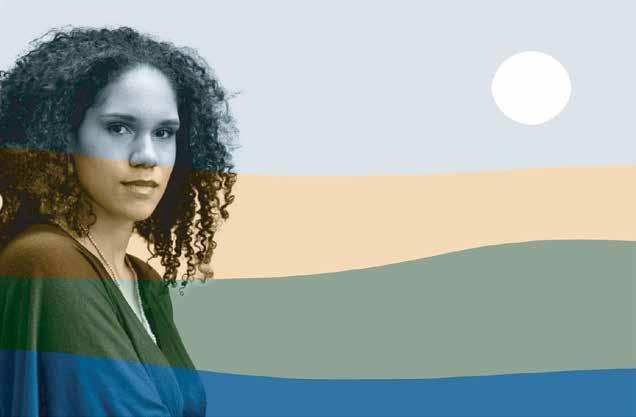

Georgia Jacobson, mezzo-soprano
Gennard Lombardozzi, tenor
Cory Renbarger, baritone
CONCERT SPONSORS:
Generously underwritten by the Pachel Foundation

34 DULUTH SUPERIOR SYMPHONY ORCHESTRA
MASTERWORKS 7 MASTERWORKS 7
RICHARD ROBBINS
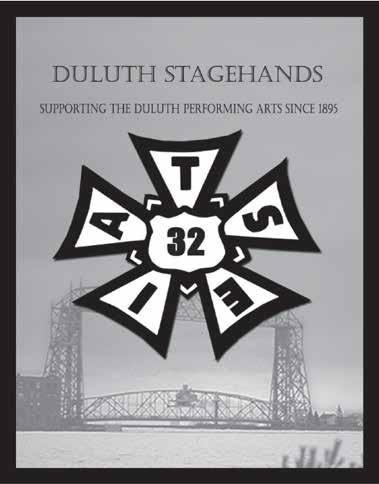

DSSO chorus master Richard Robbins is the director of choral activities at the University of Minnesota Duluth, where directs the University Singers and Chamber Singers, in addition to teaching an array of choral conducting and music courses. Robbins travels extensively as a clinician, adjudicator, and director for choral festivals and honor choirs across the country, with recent engagements in Miami, Los Angeles, Orlando, San Francisco, Chicago, Baltimore, and New York City. He has conducted and lectured internationally on multiple occasions at Warsaw’s Chopin Conservatory of Music, the John Paul II Liturgical Institute, and at Krakow’s Academy of Music. As a conductor, his performances have been featured on numerous nationally syndicated programs, including American Public Media’s Pipedreams. His extensive experience in preparing choral-orchestral performances includes leading choirs for the Houston Ballet and for over 50 performances with the Houston Symphony. He has prepared choruses for several major conductors, including Christoph Eschenbach, Ermanno Florio, Hans Graf, Joan Glover, Bernard Labadie, Klaus Peter Flor, Michael Krajewski, Stephen Cleobury, Robert Franz, and Dirk Meyer
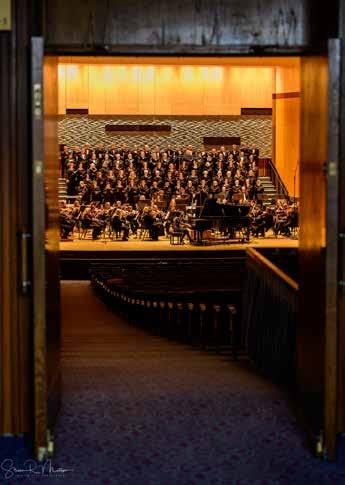
35 DULUTH SUPERIOR SYMPHONY ORCHESTRA
MUSICIAN PROFILE
OLD AMERICAN SONGS
Zion’s Walls
Come fathers and mothers, Come sisters and brothers, Come join us in singing the praises of Zion. O fathers, don’t you feel determined To meet within the walls of Zion?
We’ll shout and go round The walls of Zion.
Long Time Ago
On the lake where droop’d the willow Long time ago, Where the rock threw back the billow Brighter than snow.
Dwelt a maid beloved and cherish’d By high and low, But with autumn leaf she perished Long time ago.
Rock and tree and flowing water Long time ago, Bird and bee and blossom taught her Love’s spell to know. While to my fond words she listen’d Murmuring low, Tenderly her blue eyes glisten’d Long time ago.
The Golden Willow Tree
There was a little ship in South Amerikee, Crying O the land that lies so low, There was a little ship in South Amerikee, She went by the name of the Golden Willow Tree, As she sailed in the lowland lonesome low, As she sailed in the lowland so low.
We hadn’t been a sailin’ more than two weeks or three, Till we came in sight of the British Roverie, As she sailed in the lowland lonesome low, As she sailed in the lowland so low.
Up stepped a little carpenter boy, Says “What will you give me for the ship that I’ll destroy?”
“I’ll give you gold or I’ll give thee, The fairest of my daughters as she sails upon the sea If you’ll sink ‘em in the lowland lonesome low, If you’ll sink ‘em in the land that lies so low.”
He turned upon his back and away swum he, He swum till he came to the British Roverie, He had a little instrument fitted for his use, He bored nine holes and he bored them all at once. He turned upon his breast and back swum he, He swum till he came to the Golden Willow Tree.
“Captain, O Captain, come take me on board, And do unto me as good as your word For I sank ‘em in the lowland lonesome low, I sank ‘em in the lowland so low.”
“Oh no, I won’t take you on board, Nor do unto you as good as my word, Tho’ you sank ‘em in the lowland lonesome low, Tho’ you sank ‘em in the land that lies so low:’
“If it wasn’t for the love that I have for your men, I’d do unto you as I done unto them, I’d sink you in the lowland lonesome ow, I’d sink you in the lowland so low:’
He turned upon his head and down swum he, He swum till he came to the bottom of the sea. Sank himself in the lowland lonesome ow, Sank himself in the land that lies so low.
The Little Horses
Hush you bye, Don’t you cry, Go to sleepy little baby. When you wake, You shall have, All the pretty little horses. Blacks and bays, Dappls and grays, Coach and six-a little horses. Blacks and bays, Dapples and grays, Coach and six-a little horses.
Hush you bye, Don’t you cry, Go to sleepy little baby. When you wake, You’ll have sweet cake and All the pretty little horses. A brown and gray and a black and a bay and a Coach and six-a little horses.
A black and a bay ad a brown and a gray and a Coach and six-a little horses.
Hush you bye, Don’t you cry, Oh you pretty little baby. Go to sleepy little baby. Oh you pretty little baby.
36 DULUTH SUPERIOR SYMPHONY ORCHESTRA MASTERWORKS 7
I Bought Me a Cat
I bought me a cat, my cat pleased me, I fed my cat under yonder tree. My cat says fiddle eye fee.
I bought me a duck, my duck pleased me.
I fed my duck under yonder tree.
My duck says, ‘Quaa, quaa’, My cat says fiddle eye fee.
I bought me a goose, my goose pleased me.
I fed my goose under yonder tree.
My goose says, ‘Quaw, quaw’, My duck says, ‘Quaa, quaa’, My cat says fiddle eye fee.
I bought me a hen, my hen pleased me.
I fed my hen under yonder tree.
My hen says, Shimmy shack, shimmy shack’, My goose says, ‘Quaw, quaw’, My duck says, ‘Quaa, quaa’, My cat says fiddle eye fee.
I bought me a pig, my pig pleased me.
I fed my pig under yonder tree.
My pig says, ‘Griffey, griffey’.
My hen says, Shimmy shack, shimmy shack’, My goose says, ‘Quaw, quaw’, My duck says, ‘Quaa, quaa’, My cat says fiddle eye fee.
I bought me a horse, my horse pleased me. I fed my horse under yonder tree.
My horse says, ‘Neigh, neigh’, My pig says, ‘Griffey, griffey’.
My hen says, Shimmy shack, shimmy shack’, My goose says, ‘Quaw, quaw’, My duck says, ‘Quaa, quaa’, My cat says fiddle eye fee.
I bought me a cow, my cow pleased me. I fed my cow under yonder tree.
My cow says ‘Moo, moo’, My horse says, ‘Neigh, neigh’, My pig says, ‘Griffey, griffey’.
My hen says, Shimmy shack, shimmy shack’, My goose says, ‘Quaw, quaw’, My duck says, ‘Quaa, quaa’, My cat says fiddle eye fee.
I bought me a wife, my wife pleased me.
I fed my wife under yonder tree. My wife says, ‘Honey, honey’, My cow says ‘Moo, moo’, My horse says, ‘Neigh, neigh’, My pig says, ‘Griffey, griffey’.
My hen says, Shimmy shack, shimmy shack’, My goose says, ‘Quaw, quaw’, My duck says, ‘Quaa, quaa’, My cat says fiddle eye fee.
Simple Gifts
‘Tis the gift to be simple ’tis the gift to be free ‘Tis the gift to come down where you ought to be And when we find ourselves in the place just right, ‘Twill be in the valley of love and delight.
When true simplicity is gained
To bow and to bend we shan’t be ashamed
To turn, turn will be our delight. ‘Till by turning, turning we come round right.
‘Tis the gift to be simple ’tis the gift to be free ‘Tis the gift to come down where you ought to be And when we find ourselves in the place just right, ‘Twill be in the valley of love and delight.
At The River
Shall we gather by the river, Where bright angel’s feet have trod, With its crystal tide forever Flowing by the throne of God. Yes, we’ll gather by the river, The beautiful, the beautiful river, Gather with the saints by the river That flows by the throne of God. Soon we’ll reach the shining river, Soon our pilgrimage will cease, Soon our happy hearts will quiver With the melody of peace. Yes, we’ll gather by the river, The beautiful, the beautiful river, Gather with the saints by the river That flows by the throne of God.
37 DULUTH SUPERIOR SYMPHONY ORCHESTRA MASTERWORKS 7
INSERT FOR BEETHOVEN SYMPHONY NO. 9
SEE
Sarah Lawrence is enjoying a widely varied career. Her rapidly expanding repertoire includes oratorio, operetta, opera and musical theatre. The release of her CD, Sweet Hello, marks her debut as a recording artist. Sarah’s concert repertoire shows her versatility. She has performed Handel’s Messiah with the symphonies of Omaha, Madison, Cheyenne, and the Apollo Chorus in Chicago’s Orchestra Hall. With Wisconsin’s Peninsula Music Festival she has sung Haydn’s Creation and Bach’s B Minor Mass. Other Haydn performances have included the St. Cecilia Mass with the Rochester Oratorio Society, the Lord Nelson Mass with the North Shore Choral Society, and Paukenmesse with the Sheboygan Symphony. With the Madison Symphony Orchestra she has also performed Bach’s Magnificat and Mozart’s Mass in C Minor. She sang Prokofiev’s The Ugly Duckling and Canteloube’s Chants d’Auvergne with the Milwaukee Symphony Orchestra. She has appeared in pops concerts with the Rockford Symphony Orchestra, the Duluth Superior Symphony Orchestra and the Southwest Michigan Symphony.
Equally comfortable on the stage, Ms. Lawrence has performed the role of Masha in The Music Shop, Norina in Don Pasquale, Gretel in Hansel and Gretel, Frasquita and Micaela in Carmen, and Anne Page in The Merry Wives of Windsor. She has appeared with Madison Opera, Opera for the Young, Light Opera Oklahoma, Dorian Opera Theatre and Lyric Opera of the North. With Minnesota’s Colder By The Lake, she created the role of Missy in the world premiere of Tyler Kaiser’s Les Uncomfortables, and the role of Pristine in The Phantom of the Norshor. She appeared with Lyric Opera of the North in their production of The Magic Flute as Pamina. A huge fan of Gilbert & Sullivan’s operettas, Sarah has appeared as Rose Maybud in Ruddigore, Angelina in Trial by Jury, Yum-Yum in The Mikado, and Mabel in The Pirates of Penzance.
Ms. Lawrence appeared as Christine Daaé as a member of the Third National Tour of The Phantom of the Opera and in Phantom: The Vegas Spectacular. In recent seasons, she has also appeared as Fiordiligi in Mozart’s Cosi fan tutte with the Peninsula Music Festival, the title role in Lyric Opera of the North’s production of Semele, the soprano soloist in Beethoven’s 9th Symphony with the DuluthSuperior Symphony Orchestra, and as an Equity guest artist with The Duluth Playhouse as Eliza Doolittle in My Fair Lady. The current season includes an appearance with Colder By The Lake in Older By The Lake and a return to the Duluth Playhouse, this time as Lily in The Secret Garden, as well as another turn as Mabel in The Pirates of Penzance as a part of the Tall Ships Festival in Duluth.
A native of Duluth, Minnesota, French-born, Greek-American mezzo-soprano Georgia Jacobson debuts this season with Kentucky Opera as Tisbe in La Cenerentola and Maggie in The Gift of the Magi, and Opera Santa Barbara as Lucilla (cover) in La scala di seta and Waltraute in Die Walküre. Her recent engagements in 2022 include covering the role Virginia Woolf in the world premiere/concert version of The Hours by composer Kevin Puts and librettist Gregory Pierce at the The Philadelphia Orchestra, covering the role of Hermia in Britten’s A Midsummer Night’s Dream at Des Moines Metro Opera, and singing the role of Hannah Before in Kaminsky’s As One with Lyric Opera of the North. In March 2022, Jacobson returned home to Minnesota to premiere two song cycles, both commissioned for her by The Schubert Club and composed by Carol Barnett (Young/Old Witches, Bat) and Linda Kachelmeier (Lake Superior Songs). In previous seasons, she covered Mary Johnson (Fellow Travelers) as an Apprentice Artist at Des Moines Metro Opera (2021), and premiered the role of Sage (Everything Comes to A Head) with Lyric Opera of the North/ DeCameron Opera Coalition (2021). In January of 2021, Jacobson was a Metropolitan National Council Encouragement Award winner in the South Carolina district. Additionally, Ms. Jacobson won 1st Place in the National Opera Association’s 2020 Carolyn Bailey and Dominick Argento Vocal Competition. Jacobson has a special affinity for French repertoire, and she was proud to make her professional debut with the Cincinnati Symphony Orchestra in their production of Ravel’s L’enfant et les sortilèges as Maman/Tasse/ La libellule under the baton of Maestro Louis Langrée. A consummate musician and lover of new music, she workshopped the roles of Virginia Woolf (The Hours), Ruth (Awakenings) and Vesta (Fierce) with Opera Fusion: New Works and Cincinnati Opera. Her other roles include Cherubino (Le nozze di Figaro), Zweite Dame (Die Zauberflote) and Endimione (La Calisto) with CCM Opera, as well as Giannetta (cover) (L’Elisir d’Amore) with Lyric Opera of the North. She holds a Bachelor’s degree in Voice Performance from University of Minnesota-Twin Cities, and Master’s of Music (Voice) from University of Cincinnati – College Conservatory of Music, where she has recently received an Artist Diploma (Opera Performance).


38 DULUTH SUPERIOR SYMPHONY ORCHESTRA
MUSICIAN PROFILE
Sarah Lawrence
Georgia Jacobson
Establishing himself as a successful performer in opera, oratorio, and musical theatre repertoire, tenor Gennard Lombardozzi has been heard on stages throughout the United States, Europe and Asia. Some of his roles include Tonio in La fille du régiment, Count Almaviva in Il barbiere di Siviglia, Camille in The Merry Widow, Tamino in Die Zauberflöte, Rodolfo in La Boheme, Edgardo in Lucia di Lammermoor, Tito in La clemenza di Tito, Ernesto in Don Pasquale, Fenton in The Merry Wives of Windsor, and Lysander in A Midsummer Night’s Dream. Gennard has performed with Gotham Chamber Opera, Virginia Opera, New York Festival of Song, The Glimmerglass Festival, Alba Music Festival, Knoxville Opera, Opera in the Heights, Central City Opera, New York Grand Opera, Lyric Opera of the North, Rimrock Opera, Fargo-Moorhead Opera, Taconic Opera, The Hollywood Film Orchestra, Mineola Choral Society, The Occasional Opera Company, and others.

In parallel to his notable performance career, Gennard has also established himself as n\an accomplished educator. His understanding of vocal pedagogy and its application is supported by college level teaching in outstanding music programs including Yale University, Stephen F. Austin State University, Fairfield University, Maryville College, Pellissippi State Technical College, and Naugatuck Valley Community College. Experienced in all genres of vocal performance, Gennard’s students have made way in the critically acclaimed Whiffenpoofs, Duke’s Men, Red Hot and Blue, Yale Camerata, Yale Repertory Theatre, and have thrived on the opera and recital stages within his affiliated universities. Gennard’s students have also found success in Off-Broadway shows, television sitcoms, and commercials, and have gone on to graduate school in voice, conducting, and composition, at the Juilliard School, Eastman School of Music and the Cincinnati Conservatory of Music. Gennard completed his DMA at Stony Brook University, MM at the University of Tennessee, and BM at Concordia College Moorhead.
Baritone Cory J Renbarger has performed with companies such as Florida Grand Opera, Dayton Opera, Opera Theater Festival in Lucca, Italy, Minnesota Opera, Chicago Opera Theater, Fargo-Moorhead Opera, The Dayton Philharmonic Orchestra, Duluth-Superior Symphony Orchestra, LOON Opera and others. Some of his notable roles have included Mozart’s Figaro, Don Giovanni, and Guglielmo, Britten’s Tarquinius, and Puccini’s Sharpless and Gianni Schicchi. In 2008, Cory was a national semi-finalist in the Metropolitan Opera National Council Auditions. In 2017, he joined the faculty for the Northern Lights Opera Festival in Hibbing, MN, where he also sang the role of Zaretsky in Tchaikovsky’s Yevgény Onégin. Some of Cory’s recent concert work includes Fauré’s Requiem with the Duluth-Superior Symphony Orchestra and also with Magnum Chorum, Fargo-Moorhead Opera’s 50th Anniversary Gala, and Schubert’s Winterreise with Dr. Stephen Carlson. Alongside multiple performances of Winterreise, stretching from Arizona to Alaska, Renbarger and Carlson released a commercial recording of the work in July of 2022. In addition to his performance work, Cory has directed over a dozen opera productions, including Mozart’s Die Zauberflöte, Gilbert and Sullivan’s The Pirates of Penzance and many others. Most recently, he directed a triple bill of Menotti’s The Telephone, Barber’s A Hand of Bridge and Moore’s Gallantry. Upcoming engagements include a return to LOON Opera as Alfio in Cavalleria Rusticana this June and a featured performance of Nathan Jones’ Three Ojibwe Stories at the 2023 International Clarinet Association’s Clarinetfest in July. Dr. Renbarger is currently Professor of Music in Voice at Bemidji State University and resides in Bemidji, MN with his wife, Amanda and their daughter, Bella.

39 DULUTH SUPERIOR SYMPHONY ORCHESTRA
Gennard Lombardozzi
MUSICIAN PROFILE
Cory Renbarger
JESSIE MONTGOMERY
JESSIE MONTGOMERY
BORN: 1981, in New York City, New York
WORK COMPOSED: : 2014 (string orchestra version); 2017 (chamber orchestra version)
WORLD PREMIERE: September 2014, by the Sphinx Virtuosi, in Miami, Florida
PERFORMANCE HISTORY: This is the first DSSO performance of Banner. The only other work by Jessie Montgomery given by the Orchestra was the string orchestra version of Strum on October 17, 2020, with Dirk Meyer conducting.
INSTRUMENTATION: Two flutes (2nd double piccolo), oboe, clarinet, bassoon, horn, trumpet, timpani, percussion (tom-tom, kick drum, snare drum) and strings.
DURATION : 8 minutes.
Jessie Montgomery was raised in the Lower East Side of Manhattan by musical parents. She began violin studies at the Third Street Music School Settlement and continued on to receive a bachelor’s degree in violin performance from the Juilliard School. In 2012 she completed a master’s degree in Composition for Film and Multimedia at New York University. Montgomery became involved with the Detroit-based Sphinx Organization in 1999. The Sphinx Organization supports young African American and Latinx string players. In May 2021, she began her appointment as the Mead Composer-in-Residence with the Chicago Symphony Orchestra.
During the War of 1812 Francis Scott Key was held prisoner by the British in Baltimore Harbor. The British had already burned much of Washington, D.C. and started to turn their attention to Baltimore. If Fort McHenry were to be neutralized the British troops would freely enter Baltimore and burn it to the ground. Key penned a poem that details his relief at seeing the flag and rejoicing in the promise of victory. Key set his poem to John Stafford Smith’s The Anacreontic Song, the official song of the Anacreontic Society, an 18th century gentlemen’s club of amateur musicians in London. The club existed from approximately 1766 to 1792 and consisted mainly of wealthy men of high social rank. The Society met twelve times a year, on Wednesdays, and began at half past seven in the evening with a lengthy concert featuring the best performers in London. Contrary to popular belief, the song celebrated the club and was not used as a drinking song.
Within a short time The Star-Spangled Banner was popularly considered the National Anthem for the expanding country; however it wasn’t until 1931 that Herbert Hoover signed the legislation to make it official. Montgomery’s Banner was written as a tribute to the 200th anniversary of The Star-Spangled Banner. In her program notes she describes the work: Banner is a rhapsody on the theme of The Star-Spangled Banner. Drawing on musical and historical sources from various world anthems and patriotic songs, I’ve made an attempt to answer the question: “What does an anthem for the 21st century sound like in today’s multicultural environment?”
In 2009, I was commissioned by the Providence String Quartet and Community MusicWorks to write Anthem: A tribute to the historical election of Barack Obama. In that piece I wove together the theme from The Star-Spangled Banner with the commonly named Black National Anthem Lift Every Voice and Sing by James Weldon Johnson (which coincidentally share the exact same phrase structure). Banner picks up where Anthem left off by using a similar backbone source in its middle section, but expands further both in the amount of references and also in the role play of the string quartet as the individual voice working both with and against the larger community of the orchestra behind them. The structure is loosely based on traditional marching band form where there are several strains or contrasting sections, preceded by an introduction, and I have drawn on the drum line chorus as a source for the rhythmic underpinning in the finale.

40 DULUTH SUPERIOR SYMPHONY ORCHESTRA MASTERWORKS 7
Banner for Solo String Quartet and Chamber Orchestra (2017)
Within the same tradition, I have attempted to evoke the breathing of a large brass choir as it approaches the climax of the “trio” section. A variety of other cultural Anthems and American folk songs and popular idioms interact to form various textures in the finale section, contributing to a multi-layered fanfare. The StarSpangled Banner is an ideal subject for exploration in contradictions. For most Americans the song represents a paradigm of liberty and solidarity against fierce odds, and for others it implies a contradiction between the ideals of freedom and the realities of injustice and oppression. As a culture, it is my opinion that we Americans are perpetually in search of ways to express and celebrate our ideals of freedom — a way to proclaim, “we’ve made it!” as if the very action of saying it aloud makes it so.
And for many of our nation’s people, that was the case: through work songs and spirituals, enslaved Africans promised themselves a way out and built the nerve to endure the most abominable treatment for the promise of a free life. Immigrants from Europe, Central America and the Pacific have sought out a safe haven here and though met with the trials of building a multi-cultured democracy, continue to find rooting in our nation and make significant contributions to our cultural landscape. In 2014, a tribute to the U.S. National Anthem means acknowledging the contradictions, leaps and bounds, and milestones that allow us to celebrate and maintain the tradition of our ideals.
—- Jessie Montgomery
Old American Songs AARON COPLAND
BORN: November 14, 1900, in Brooklyn, New York
DIED: December 2, 1990, in North Tarrytown, New York
WORK COMPOSED: 1950 (set 1); 1952 (set 2)
WORLD PREMIERE: June 17, 1950, in Aldeburgh, England; Peter Pears, tenor and Benjamin Britten, piano (set 1); July 24, 1953, in Ipswich, Massachusetts; William Warfield, baritone and Aaron Copland, piano (set 2)
PERFORMANCE HISTORY: These Copland versions of three songs were only played by the DSSO on April 19, 1996. Jubilant Sykes was the baritone soloist with Yong-yan Hu conducting.
INSTRUMENTATION: Flute (double piccolo), oboe, two clarinets, bassoon, two horns, trumpet, trombone, harp and strings.
DURATION : 22 minutes.
Until his death Aaron Copland was considered the dean of American composers for serious music, while Irving Berlin unquestionably held that title for popular music. Therefore it isn’t surprising that Aaron Copland would arrange a number of Old American songs that evoke nostalgia for the distant American past.
AARON COPLAND
Copland’s music has painted musical portraits of American life in many of his works: Ballet for Martha (Appalachian Spring) depicting 19th century pioneers in Pennsylvania celebrating after building a new farmhouse; the ‘Wild West’ depiction in Billy the Kid; life on a western ranch in Rodeo; Lincoln Portrait and Fanfare for the Common Man, which have become patriotic standards. It is difficult to pigeon-hole Copland. On one hand it appears that he was nostalgic for a simpler life, but on the other hand he was experimenting with more modern music, such as his Concerto for Piano, Symphony No. 3, Piano Quartet, Orchestral Variations and Connotations

41 DULUTH SUPERIOR SYMPHONY ORCHESTRA
MASTERWORKS 7
Benjamin Britten asked Copland to arrange a set of American folk songs for the Aldeburgh Festival of Music and the Arts, which was founded in 1948 by Britten, Peter Pears and Eric Crozier. It is held each June in Aldeburgh, England and features an eclectic range of music from the classics (Bach, Haydn, Mozart, et al) to new works by contemporary composers.
Copland set about doing his research in the John Hay Library at Brown University, the home of the Sheet Music Collection of the Harris Collection of American Poetry and Plays, which contains approximately 500 thousand pieces of sheet music dating from the late 18th century to the present day. The initial iterations of the arrangements were for voice and piano. Copland created an orchestral arrangement of the first set for baritone and it was premiered on January 7, 1955, by William Warfield and the Los Angeles Philharmonic, conducted by Alfred Wallenstein. In its orchestral form, Copland set the second set for a mezzo-soprano and it was premiered on May 25, 1958, by Grace Bumbry and the Ojai Festival Orchestra, conducted by Copland. The songs Copland chose are:
Set 1
The Boatman’s Dance
The Dodger
Long Time Ago
Simple Gifts
I Bought Me a Cat
Set 2
The Little Horses
Zion’s Walls
The Golden Willow Tree
At the River
Ching-A-Ring Chaw
The Boatman’s Dance, most likely written by Daniel Decatur Emmett (1815-1904), is an 1843 minstrel song celebrating the Ohio River boatmen. The Dodger was a campaign song used by Grover Cleveland in the 1884 Presidential election to belittle his opponent James G. Blaine. Simple Gifts is the familiar Shaker melody Copland used in Appalachian Spring. I Bought Me a Cat is a cumulative song about farm animals, also known as the Farmyard Song, that originated in the British Isles and was also sung in North America. At the River is the popular hymn, Shall We Gather at the River?, written by Baptist minister Robert Lowry (1826-1899). Ching-A-Ring Chaw is a song from the early days of the minstrel show tradition. Because it was originally a ‘blackface’ minstrel song, Copland made a point of rewriting the lyrics to remove any of its minstrel baggage: “I did not want to take any chance of it being construed as racist.”
Much of America’s innocence was beginning to fade when Copland wrote these two sets of Old American Songs. The Second World War had only been over for five years and the Cold War was raging. The simplicity of the songs included in these two sets, coupled with Copland’s sensitive treatment, seems to point to his desire to return to a less complicated time.
LUDWIG VAN BEETHOVEN
Symphony No. 9 in D minor, Op. 125 Choral
LUDWIG VAN BEETHOVEN
BORN: December 17 (baptized), 1770, in Bonn
DIED: March 26, 1827, in Vienna

WORK COMPOSED: 1824
DEDICATION: Friedrich Wilhelm III of Prussia
WORLD PREMIERE: May 7, 1824, in Vienna at the Theater am Kärntnertor; Michael Umlauf conducting, Henriette Sontag, Caroline Unger, Anton Haitzinger and Joseph Seipelt, soloists
PERFORMANCE HISTORY: Beethoven’s Ninth is being performed for the twelfth time by the Orchestra and Chorus. It was also heard in 1938, 1954, 1961, and on April 22, 1966, which was the final DSSO performance at its former home in the Duluth Armory. Other performances include April 30, 1977 with Joseph Hawthorne conducting the final concert of his 10-season tenure as Music Director, 1985, 1995 (with then guest-conductor Taavo Virkhaus), 1999, 2004, 2009, and May 2, 2015 under the baton of Dirk Meyer.
INSTRUMENTATION: Two flutes, piccolo, two oboes, two clarinets, two bassoons, contrabassoon, four horns, two trumpets, three trombones, timpani, percussion (bass drum, cymbals, triangle) , vocal soloists, chorus and strings.
DURATION : 65 Minutes.
42 DULUTH SUPERIOR SYMPHONY ORCHESTRA MASTERWORKS 7
In the 1994 movie Immortal Beloved there is a scene depicting the premiere of the Ninth Symphony where Beethoven, played by Gary Oldman, stands on stage and stares blankly at the musicians. He is unable to hear the performance and he becomes lost in a personal reverie. As he hears the Ode to Joy in his mind he recalls running away from his violently abusive father. We hear the music as the young Beethoven is running through the woods and finally reaches a small pond. As the music comes to its climax we see him lying in the water showing him as he becomes one with the cosmic heavens. At this point the orchestra, soloists and chorus come together in what can only be described as the most profound, beautiful experience akin to becoming one with the universe.
The Philharmonic Society of London commissioned the symphony in 1817. Beethoven did most of the work between the autumn of 1822 and February 1824. The Ninth grew out of other works Beethoven had completed but which were also in some sense sketches for a future work. This is evident in his Choral Fantasy (Op. 80) from 1808, which is essentially a piano concerto movement with chorus and orchestra. However, the Ninth is the first symphony by a major composer to incorporate vocal soloists and chorus.
The last decade of Beethoven’s life was melancholic and challenging; by this time he was completely deaf. Goethe met Beethoven in the summer of 1812 in the Bohemian spa resort in Teplitz. He wrote of Beethoven that:
Beethoven was sensitive to and influenced by the political realities of his time. In 1814-15, European leaders met together at what was called the Congress of Vienna, with the goal of creating a better balance of power and peace throughout Europe. These leaders were strong conservatives and had little use for revolutionaries or liberals. Therefore, many people viewed the resulting atmosphere as oppressive and restrictive.
The idea for setting Friedrich Schiller’s poem Ode to Joy to music came from Beethoven’s reaction to this political situation. The poem, written in 1785, embodies the revolutionary fire of that era. We might think of Schiller’s poem as we do the song from the musical Les Misérables – Do You Hear the People Sing, comrades raising their glasses in revolutionary solidarity. Beethoven uses Schiller’s fire-drunk song as a hymn to friendship, freedom, marriage and universal brotherhood. Leonard Bernstein conducted the Ninth on Christmas Day, 1989, in Berlin only a month after the opening of the Wall. For the concert it became the Ode to Freedom and Bernstein changed Schiller’s poem from Freude (Joy) to Freiheit (Freedom).
They would walk together through the streets and when royalty approached Goethe stepped aside, bowed deeply and tipped his hat; Beethoven remained indifferent and walked on. That was Beethoven’s character: defiant, individual, strongly humanitarian and intolerant of hypocrisy.
The premiere of the Ninth was on May 7, 1824 (the London premiere was not until March 21, 1825). Included on the program was the overture The Consecration of the House and the Kyrie, Credo and Agnus Dei from his Missa solemnis. This was the first time Beethoven had been on a public stage in 12 years and the hall was packed. The large orchestra consisted of many of Vienna’s most elite performers. The performance was officially conducted by Michael Umlauf with Beethoven sitting nearby giving tempos for each section. According to violinist Joseph Böhm, “Beethoven directed the piece himself; that is, he stood before the lectern and gesticulated furiously. At times he rose, at other times he shrank to the ground, he moved as if he wanted to play all the instruments himself and sing for the whole chorus.” At the end the audience cheered and wildly applauded, but Beethoven was facing the orchestra and still conducting. Caroline Unger, the contralto soloist, walked over and turned the maestro around to accept the applause. One witness recalled, “the public received the musical hero with the utmost respect and sympathy, listened to his wonderful, gigantic creations with the most absorbed attention and broke out in jubilant applause…”
43 DULUTH SUPERIOR SYMPHONY ORCHESTRA MASTERWORKS 7
“He is an utterly untamed personality, who is not altogether in the wrong in holding the world to be detestable, but surely does not make it any the more enjoyable either for himself or for others by his attitude.”
Beethoven biographer Jan Swafford writes in his program notes for the Boston Symphony: The symphony emerges from a whispering mist to fateful proclamations. The finale’s Joy theme, prefigured in bits and pieces from the beginning, is almost constructed before our ears, hummed through, then composed and recomposed and decomposed. Which is to say, the Ninth is also music about music, about its own emerging, about its composer composing. The Ninth Symphony, forming and dissolving before our ears in its beauty and terror and simplicity and complexity, is itself Beethoven’s embrace for the millions, from East to West, high to low, naive to sophisticated. When the bass soloist speaks the first words in the finale, an invitation to sing for joy, the words come from Beethoven, not Schiller. It’s the composer talking to everybody, to history. There’s something singularly moving about that moment when Beethoven greets us person to person, with glass raised, and hails us as friends.
Beethoven is the most pivotal composer who bridges the gap between the Classical and Romantic periods of western music history. It is generally accepted that the Romantic period began around 1820-30, but an easy way to remember this is to associate it with the death of Beethoven in 1827. By the time of his Symphony No. 5, written between 180408, Beethoven is already pushing the boundaries of the Classical period. His Sixth, completed in 1808, was a groundbreaking five movement programmatic symphony – unheard of at that time. It would be a decade, after completing his Seventh and Eighth around 1811-12, before Beethoven would compose another symphony, and this one would become a masterpiece without equal. The Ninth is one of the best known and most performed works and considered by many to be the greatest piece of western music ever written.



German soldiers, who were held at the Bandō prisoner-of-war camp during World War I, introduced the Ninth to Japan. Japanese orchestras began performing the symphony in 1925 and during World War II the Imperial government promoted its performances, including on New Year’s Eve. By the 1960s performances became more widespread and now the symphony is traditionally performed throughout Japan at the end of the year. For example, in December 2009 there were 55 performances there by various major orchestras and choirs.
Nearly 200 years since its premiere the Ninth continues to inspire people around the world. Composers such as Brahms, Bruckner, Dvořák, Bartók and others have been influenced by it. There was also a superstition that composers associated with a ninth symphony: Beethoven never completed a tenth symphony and it was thought that once a composer completed a ninth symphony it would be their last. The superstition began with Mahler, according to Arnold Schoenberg, who after writing his Eighth Symphony wrote Das Lied von der Erde, which was structurally a symphony, but he disguised it as a song cycle. Then he wrote his Ninth Symphony and thought he had beaten the curse, but died before he could complete his Tenth. Other composers who may have been superstitious about the Ninth are Schubert, Dvořák, Bruckner and Vaughan Williams.
Modern technology has also felt its impact: the Philips Corporation news release on August 16, 2007, celebrating the 25th anniversary of the Compact Disc, mentions that Philips and Sony extended the capacity of the CD to 74 minutes to accommodate a complete performance of Beethoven’s Symphony No. 9.
MASTERWORKS 7

45 DULUTH SUPERIOR SYMPHONY ORCHESTRA Member FDIC WE PROUDLY SUPPORT THE ARTS IN DULUTH. Happy employees. Happy customers. 39076 201 E. Superior St.Duluth, MN 55802
INVEST IN THE MUSIC YOU LOVE
WAYS TO SUPPORT THE DULUTH SUPERIOR SYMPHONY ORCHESTRA
Just as it takes an ensemble to perform the great works of Beethoven, so it takes a collection of individuals to support the work of the Duluth Superior Symphony Orchestra. When you give to the DSSO, you are supporting an organization that is a cultural cornerstone of the Twin Ports region, bringing together the best of our local musicians to entertain, educate and enrich the lives of more than 20,000 individuals each year.
Your ticket purchase tonight was important - but it only covers a quarter of our annual operating expenses. Individual donors play an important part in helping the Symphony bridge that gap. Each season, gifts from individuals provide more than 60% of our contributed income. That means donations of any size make a big difference and support our efforts to share great music with everyone in the community.
WAYS TO MAKE A GIFT:
In Person - Come say hello to us at the tables in the lobby. We want to hear your stories about concerts you have enjoyed over the years.
Call the Office - We are happy to process your donation over the phone and love it when you call!
Donate Online - Give securely by visiting www.DSSO.com/give
Debit Transfer - Join other DSSO patrons and simply authorize your banker to initiate a reoccurring debit transfer from your account directly to the DSSO.
Mail Us a Check - We know it can be old-fashioned, but our office loves getting mail. 130 W. Superior St Suite LL2 - 120 Duluth, MN 55802
IRA Donation - Are you 70½ or older? You can support the music you love with a Qualified Charitable Distribution from your IRA. Please consult your tax or financial advisor for more information.
Charitable Bequest - Write your own story with planned gifts to the people & organizations you value by writing them to your Will and beneficiary designations.
Stock Donations- You can transfer appreciated stock as a gift that is fully tax-deductible.
PERPETUAL SUPPORT VIA THE LEGACY SOCIETY:
The Legacy Society recognizes and honors the visionary individuals, couples, and families who have included the DSSO in their estate plans, ensuring that the music you care about continues into the future. To join the Legacy Society, you can make a bequest to the DSSO as part of your Will, name the organization as a beneficiary in a policy or retirement fund or provide a direct cash donation into our endowment.
To begin, contact your attorney and ask for the DSSO to be included in your Will, Trust or policy. Then contact the DSSO office and we can provide you with a membership form so we can begin recognizing your generosity and including your gift in our future planning.
In recognition of their support, Legacy Society members are listed in all concert Program Books and are invited to an exclusive annual benefit event each year.
BUSINESS SUPPORT:
The Duluth Superior Symphony Orchestra (DSSO) is proud to be a part of the Twin Ports business community. The Symphony is an employer, a downtown tenant, a consumer, an advertiser, and a member of the Chamber of Commerce. We understand that each company has different needs and motivations, from marketing and brand identification to client and employee entertainment and recognition, and more. We welcome the opportunity to discuss your corporate objectives and identify customized ways we can work together for mutual benefits.
THE DSSO DONOR LOUNGE
The DSSO Donor Lounge is a space for where our most invested patrons can gather before a concert and during intermission. Access to the Donor Lounge starts with gifts to the annual fund of $1,000 and includes access to a private bartender on the second floor of the Symphony Hall Lobby Space.
46 DULUTH SUPERIOR SYMPHONY ORCHESTRA
CONTRIBUTORS
DSSO CONTRIBUTORS
THANK YOU TO THE FOLLOWING CORPORATE AND INDIVIDUAL CONTRIBUTORS WHO HAVE GIVEN IN SUPPORT OF THE DSSO JULY 1, 2021 THROUGH JANUARY 23,2023.
MAESTRO
($25,000 & up)
Charles & Carolyn Russell Foundation
The Depot Foundation
Margaret Ames Memorial Fund
McKnight Foundation
Minnesota State Arts Board
Muriel Whiteside Charitable Trust
PRINCIPAL
($10,000 to $24,999)
Nancy Odden & Doug Britton
Jeremy & Carol Fryberger
Helena Jackson
Lloyd K. Johnson Foundation
Elisabeth C. Mason
Joseph & Cheryl Meese
North Shore Bank of Commerce
Northland Foundation
Pachel Foundation
Dr. Ann Rock
Arend J. & Verna Sandbulte
St. Luke’s Medical Center
Wildey H. Mitchell Family Foundation
GUEST ARTIST
($6,000 to $9,999)
Adelaide M. Cline
Essentia Health
Gary & Jacqueline Foley
Michael & Sharon Mollerus
National Bank of Commerce
Vern & May Nordling
William & Saundra Palmer
Robert & Sharon Wahman M.D.
FULL CHAIR
($4,500 to $5,999)
Karl Diekman
Thomas & Barbara Elliott
The Teberg Fund
Minnesota PowerAn ALLETE Company
Shirley Tratechaud
HALF CHAIR
($2,500 to $4,499)
Robert T. & Barbara Bennett
John & Kathy Berchild
The Honorable David & Gloria Bouschor
Adelaide M. Cline
Dr. Beth Gilbert
Christabel & James Grant
Sylvia Jamar
Mark & Grace H. Monson
Kathleen & James Sanders
Timothy Sandor
Brad Schmugge
James & Jacquie Sebastian
Bill Stack of Stack Bros. Mechanical Contractors
Carolyn Sundquist
QUARTER CHAIR
($1,200 to $2,499)
Dr. Vicki & Terry Anderson
Sandra Borklg
Linda & Mark Boben
Lurene Buhrmann
Allison Clarke
Jeffrey & Vickie Cadwell
Stephen Cushing
Mark Danielson & Theresa Smith
Kate Dean
Lester Drewes
Roger & Elaine Engle
Dr. Robert & Mary Evans
Harold & Ruth Frederick
Lane Fryberger Smith
Walter & Kay Gower
John Fochs of Happy Sleeper Mattress
Dr. Glen E. Holt
Tom & Jill Kaiser
Elaine Killen
Robert Knighton
Patricia & David Mast
Nancy Melander
Heather Muster
Tammy Ostrander & Tony Barrett
Dean Peterson
Branden Robinson
William & Nairi Stack
Roberta Vose
James & Mary Zastrow
ACCELERANDO
($600 to $1,199)
Bill Anderson
Ruth Ann Eaton
Rondi Erickson
Mary & Joe Gummerson
Kay Gustafson
Thomas & Joan Hedin
Christine Hensolt
Ruth Johnson
Margaret Joynes
John & Sharon Kemp
Carol & Paul Knuti
Dennis Lamkin
Andre Lamourea
Darla & Gary Meier
Dirk Meyer
Gerald & Mary Ann Ostroski
David J. Ouse
Susan Relf M.D.
Karen Ruedi Crowell
Tobin Sobaski & Kari Koehler
Anita Swanson
Sharon L. Torrison
Rajiv Vaidyanathan & Emily Rose
Gudrun & Geoffery Witrak
Cathy & Kirby Wood
ADAGIO
($200 to $599)
Jerry Ackerman
Janet Akervik
John Alexander
John & Cathy Ameel
Evelyn M. Anderson
Richard & Yvonne Anderson
Kathleen Antilla
Allen Anway
Dorothy Anway
Beth Arnson
Charles R. Babst
Linda Backman
Leonore & Robert Baeumler
Susan Bathory & Donald Lane
Benedictine Sisters of St. Scholastica Monastery
Anne Bier
Janice Biga
Angie Bomier
Bruckner Society of America, Inc.
Maryjane Burdge
Bill & Renee Burns
Jan Carey
Jay Carlsgaard
Terrence & Kathy Clark
47 DULUTH SUPERIOR SYMPHONY ORCHESTRA
CONTRIBUTORS
Jerry Curnow
Daniel & Catherine Mundt
Charitable Fund
Kate Dean
Carol & Michael Donahue
R. Craft & Ellie Dryer
Jeanne Doty
Paul Enenbach
Martha & Conrad Firling
Julie A. Ford
Louise (Margaret) Foss
Patricia Gannon
Gregory R. Garmer
Carlton Gustafson
Linda Haagensen
Mary Kay Hagen
Lois & Bob Heller
Joyce & Robert Hickman
Bob Hjort
Jill-Ann Hoag
Ann Hockman
Mary Ann & Oliver Houx
Kenneth Jackson
James Jarocki
James R. Johnson
Ronald Kari
John & Beth Kelly
Gale & Jeri Kerns
Richard D. Kivela
Tina Koecher
Dr. James & Mary Krook
James Lampi
Katherine Kuettel
J. Clark & Jean Laundergan
Charles & Jean Leibfried
Michael Lillo
Gary Loberg
Paul Lokken
John & Michelle Magdsick
Ann Mars
Dean & Kate McCall
Betty Melde
Mark & Nancy Melhus
Julie Michels
William Miner
Wende Morrell
Brittany Muhlenkort
Judith A. Newman
Barbara L. Olson
Bonnie Pass
Kenneth & Sandra Rausch
Father Andrew Ricci
Joseph & Catherine Roby
Kathleen Risku
Rebekah Rud
Gerald & Karen Ruona
Patty Salo Downs
John Schilling
Helen Sever
Dr. Tomas & Janice Shuey
Mark & Sandra Signorelli
Kay Slack
Nadine Srdar
James H. Stewart
Kathy Stinnett
Thom & Cindy Storm
Mary Tennis
Andrew Thompson
Lucas Trea
Therese Vaughn
Christopher Virta
Claudia Welty
TEMPO (up to $199)
Martha Aas
Richard Abel
John J. Agacki
Andrea Agar
Brad Alm
Gwendolyn Anderson
Kade Anderson
Sylvia Angradi
Allan Apter
J. David Arnott
Ramin Artang
Carla Bailey
Judith Bailey
Thomas & Mary Jean Barratt
Jane & Thomas Barthell
Dr. Niles H. Batdorf
Lois Bauer
Carla Bayerl
Bridget Bemis
Lisa Benson
Daniel & Marjorie Bergeland
Loren & Gladys Bergstedt
Cynthia & Steven Betzler
Audrey Beyer
Damita Beyer
Kay Biga & Patrick Spott
David & Karen Bjorkman
Ronald Blaisdell
Jill & Dave Blazevic
Bryan Block
Charles Block
Gary Boelhower & Gary Anderson
Thomas & Mary Boman
Rhianna Brodin
Paula Buchanan
Trilby Busch
Jose Cabrera
Mary Ann Campbell
Ronald Caple
Jean & Sharon Captain
Reverend Craig S. Carlson
Lea Carr
Center for Muscle & Joint
Therapy
Central Minnesota Youth
Orchestra
Eun Joo Choi
Timothy & Leslie Churchill
Jan Cleary
Katie Comley Stevenson
William & Kathy Croke
John & Judy Dahl
Catherine Dahlberg
Joel Day
Dorothy Dayton
Julie Demgen
Diane Desotelle
Tom Donahue
Mary Dragich
Jacob Dunlap
Nancy Eaton
Paul Eckhardt
Ronald A. Ellefson
Joanne & Tom Ellison
Paul Engebretson
Donald Erickson
Dennis & Jeanne Erickson
Paul Eskuche
Marie Fegley
Diane Felde-Fink
Anya Felts
Jason Fife
Connor Filipi
Karen Finseth
Marjorie Fisher
Ernie Forgach
Joel Forgacs
Greg Fox
Rebecca Fulin
Donald & LouAnne Gaalaas
David & Barbara Gaddie
Gary Gange
Cole Gasper
Geoffrey Gates
Mary Gdula
John Gibbs
Jane Gilley
Sarah Glesner
Hilary Godard
Mary Godfrey
Janelle Gomez
Robert Goodell
Della K. Graham
Rosemary Guiney
Trammell Gutierrez
Elizabeth Hall
Martha Han
Dr. Vernon Harrington
Kathleen Hatch
Margaret M. Hayes
Cheryl Hedgecock
Ellen Hedin
Clay Helberg
David & Mary Helf
Helen Helgestad
Thomas Henning
Sara Henriksen
48 DULUTH SUPERIOR SYMPHONY ORCHESTRA CONTRIBUTORS
Grace Herried
Jill Hilliard
Susan Hjort
Gwen Hoberg
Mary & Allen Hoberg
Lisa Hoch
Kevin & Carol Hoeschen
Jeremy Hoglund
Wayne Holmberg
Kerri Holm-Eberling
Mary Holm-Lund
Timothy Horyza
Susan Hough
Jane Hovland
Robert D. Howe
Laura Howland
Patrick Hughes
Dan Jaeckel
Debra Jensen
Jana Jensen
Dennis & Susan Johnson
Evan Johnson
Leif Johnson
Reverend Mark R. Johnson
Aziza Jones
Jennifer & Erik Julsrud
Marissa Kari
Kelly Katzmarek
Meg Kearns
Karen & John Keenan
Georgia L. Keeney
Carol & Robert Kelley
Andrew Kim
Melissa King
Diane Kolquist & James Seitz
Steven Koszarek
Rachel Krajewski
Rena Kraut
Pat Kruschke
Damien Kujawa
Cot LaFond
Barbara & David LaMaster
Cheryl Lancette
Dan Larson
Susan Larson Kidd
Abigail Latanich
Peter Lawson
Sharon Layon
Paul & Marsha Lee
Melissa Lentz
Tony & Renate Lischalk
Bonnie & Robert Lloyd
Michael Lucas
Joyce Lund
Charlie Lydon
Michael Lyons
Judy MacGibbon
Tiffany Martin
Cindy Martinson
Cari Matheson
Maya Mattke
Cathy & Dan McCarty
Debra McDonald
James McLeod
Karen McManus
Nancy McParlan
Rosanne Mellesmoen
Elena Metcalf
Carol Michaelson
Norma Miles
Patricia Miller
William Miller & Stephanie Hemphill
Tom Morehouse
Penelope Morton
Nora Moss
Karen Munnelly
Mary Negus
Leigh Neitzel
Hannah Nelson
Susan & Charles Nelson
David Neustel
Benjamin Nilles
Phil & Lorraine Norrgard
Ann M. Novack
Emily Nygren
Pamella J. Oberfeld
Margaret (Peg) Oman
Myrna Orensten
Timothy Panula
Lacey Parr
All Parrella
Barb & Noel Pearman
Judith Pearson
Kristina Pederson
Linda Peplinski
Kenrea Perell
Kimberly Pintok
Jack Place
Mary Planten-Krell
Chuck & Della Pleski
Jessica Polacheck
Kim Quinones
Nancy & Roger Ralston
Brian & Suzanne Rauvola
Lance Reasor
Richard & Jennifer Robbins
Eric Rodvold
Michael & Betsy Rosenzweig
Terri L. Sabby
Dean Sandstrom
Keiko Satomi
Diane Sauer
Steve Savageau
Nichole & Jeffrey Schaefer
Barbara Schlichting
Sam Schmall
Randy Schmidt
Theodore Schoen
Ernst Schoenfeld
Linda Schwartz
Shelly Schwarz
Dr. Penny Schwarze
Doug Scott
Laila Seidakhmetova
Jack & Cindy Seiler
Judy Seliga-Punyko
Laurie & Mark Severson
Charlene Shimmin & Don
Lemmerman
Paul & Vicky Siders
Reier Sjomeling
Melissa Skelton
Sandy Skrien
Beth Sobczak
Tina Solots
Lawrence Spears
Nathan & Ritarae Stadler-Sager
Michelle Stark
Stacey Stark
David Steininger & Lori Williams
Sophie Stone
Clifford & Lucia Storr
Paul Straka
Tim Stratton & Suzanne
Wasilczuk
Scott Sueker
Nicholas Susi
Shirley Swenson
Linnea Swenson Tellekson
Philip Sylla
Kari Tandberg
Philip Tarnowski
Kathleen Thibault
Ruth & Dale Thorpe
Adrienne Thureen
Andrew Turpening
Tiss Underdahl
Jeff Urbaniak
UW – Eau Claire Haas Fine Arts
Center
Laurie Van Brunt
Logan Vander Wiel
Brandon VanWaeyenberghe
Sam Verduzco
Jennifer Wabrowetz
Jori & Chuck Walt
Rachel Warner
Sheldon & Susan Watts
Elizabeth Weberg
Carol & Mark Weitz
Trevor White
Laura Whitney
Josh & Janelle Wightman
Tom & Linda Wiig
Kelly Wiisanen
Susan Wittkopf
Mandi Wojciehowski
Stan & Mona Wold
Shirley Wuchter
Yasuyo Yamazaki
John Zallar
Rebecca Zunkerr
49 DULUTH SUPERIOR SYMPHONY ORCHESTRA CONTRIBUTORS
Honoring Ron Kari’s 60 years with the DSSO
Martha Aas
John Alexander
John & Cathy Ameel
Dr. Vickie & Terry Anderson
Kathleen E. Antilla
Leonore & Robert Baeumler
Thomas & Mary Jean Barratt
Thomas & Jane Barthell
Susan Bathory & Donald Lane
John & Kathy Berchild
Kay Biga & Patrick Spott
Linda & Mark Boben
Honorable David Bouschor
Jeffrey Cadwell
Ronald Caple
Jean & Sharon Captain
Rev. Craig Carlson
Timothy & Leslie Churchill
Mark Danielson
Jeanne & Daniel Doty
Patty Salo Downs
R. Craft & Ellie Dryer
Joanne & Tom Ellison
IN HONOR
Mary & Bob Evans
Louise Foss
Greg Fox
Harold A. Frederick
Lane Fryberger Smith
Dr. Beth Gilbert
Jane Gilley
Mary Godfrey
Walter and Kay Gower
Christabel and James Grant
Thomas & Sandra Henning
Joyce & Robert Hickman
Jill Hilliard
Jane Horland
Linda Jorgenson & Jack Gunderson
Pamella Jacobson
Dan & Lois Jaeckel
Sylvia Jamar
Karen Keenan
John & Sharon Kemp
Gale and Jeri Kerns
Elaine Killen
Diane Kloquist
Rena Kraut
Pat Kruschke
Cot Lafond
Charles & Jean Leibfried
James Lake & Melissa Lentz
Renate & Tony Lischalk
Gary Loberg
Judy MacGibbon
Bruce & Ann Mars
Nancy McParlan
Mark & Nancy Melhus
Julie Michels
Carol Michealson
Penny Morton
Judith A. Newman
Margaret (Peg) Oman
David J. Ouse
William & Saundra Palmer
Dean Peterson & Deb
Rauch
Nancy and Roger Ralston
Mary Pat Renaud
This list represents gifts being made in tribute to an individual, organization or occasion.
Kenneth & Sandra Rausch by Deborah Rausch
Cindy Seiler by Elizabeth Hall
The DSSO Chorus and Richard Robbins by Ron Kari
Vincent Osborn by Ruth & Dale Thorpe
IN MEMORY
Kathleen Risku
Michael & Betsy Rosenzweig
Kathleen Sanders
Brad Schmugge
Ernst Schoenfeld
Jacquie & Jim Sebastian
Laurie & Mark Severson
Paul & Vicky Siders
Bill & Nairi Stack
David Steininger & Lori Williams
William Miller & Stephanie Hemphill
Thom and Cindy Storm
Carolyn Sundquist
Ruth Thorpe
Robert and Sharon
Wahman M.D.
Sheldon Watts
Tom & Linda Wiig
Kelly Wiisanen
Jim & Mary Zastrow
Helena Jackson by Dr. Robert & Mary Evans
Rea3d by Janelle Gomez
Thomas Donahue by Charles & Jean Leibfried
Our hearts go out to the family and friends of musicians or patrons that have passed. *This list represents those we have been made aware of through Memorial Gifts.
Janet Bye by Roberta Vose
Sharon Wahman by Roberta Vose
Jim Herman by Shirley Herman
Kalevo & Arlyne Kokkonen by Carlton Gustafson
Helen Helberg by Clay Helberg
Richard Comley by Katie Comley Stevenson
Mary Donahue by Tom Donahue
Roberta Dumonsau by Beth Sobczak
Adeline & Joseph Sandor by Timothy Sandor
Elisabeth Mason by Christabel & James Grant
George Hovland II by Jane Hovland
Richard Braun by Kelly Wiisanen
David Vose and Don Niemi by Sharon L. Torrison
Richard Ford by Julie A. Ford
Dorothy Anway by Allen Anway
David Miller by Patricia Miller
Dr. Vernon Harrington by Terrence & Kathy Clark
Marge Kuehn by Kathleen E. Antilla
Samuel Tratechaud and Walter & Alta Moe by Shirley
Tratechaud
Lori Skog-Gourley by Kenrea Perell
Victoria Luepke by Harlan & Anita Stech
David Vose and Robert & Margie Vickers by Roberta Vose
Rodger Richards by Della K. Graham
Anne & Daryl Leibfried by Tom Donahue
Mary Donahue by Charles & Jean Leibfried
IN MEMORY OF ELLEN MARSDEN
Our hearts go out to the family and friends of Ellen Marsden who passed in March, 2022.
Christabel & James Grant Helen Helgestad Alison Clarke Cheryl Hedgecock
50 DULUTH SUPERIOR SYMPHONY ORCHESTRA CONTRIBUTORS
IN MEMORY OF ROBERT HJORT Our hearts go out to the family and friends of Robert Hjort who passed in July, 2022. Janice
Biga Kay Biga & Patrick Spott Sylvia Jamar Susan Hjort Pamella Oberfeld
PROPRINT AD
51 DULUTH SUPERIOR SYMPHONY ORCHESTRA
A BOW, SPONSORS
TAKE A BOW, SPONSORS
TAKE A BOW, SPONSORS
A BOW, SPONSORS








TAKE A BOW, SPONSORS
TAKE A BOW, SPONSORS
pleased to o er a big thank you to our sponsors for the 2021-2022 Season. generous support makes it possible for the DSSO to bring world-class concerts, programs, and community outreach to the Northland. BRAVO!









TAKE A BOW, SPONSORS
pleased to o er a big thank you to our sponsors for the 2021-2022 Season. generous support makes it possible for the DSSO to bring world-class concerts, educational programs, and community outreach to the Northland. BRAVO!
are pleased to o er a big thank you to our sponsors for the 2021-2022 Season. Their generous support makes it possible for the DSSO to bring world-class concerts, educational programs, and community outreach to the Northland. BRAVO!
















We are pleased to o er a big thank you to our sponsors for the 2021-2022 Season. Their generous support makes it possible for the DSSO to bring world-class concerts, educational programs, and community outreach to the Northland. BRAVO!
We are pleased to o er a big thank you to our sponsors for the 2021-2022 Season. Their generous support makes it possible for the DSSO to bring world-class concerts, educational programs, and community outreach to the Northland. BRAVO!
We are pleased to o er a big thank you to our sponsors for the 2021-2022 Season. Their generous support makes it possible for the DSSO to bring world-class concerts, educational programs, and community outreach to the Northland. BRAVO!
TAKE A BOW, SPONSORS

We are pleased to o er a big thank you to our sponsors for the 2021-2022 Season. Their generous support makes it possible for the DSSO to bring world-class concerts, educational programs, and community outreach to the Northland. BRAVO!
WE ARE PLEASED TO OFFER A BIG THANK YOU TO OUR SPONSORS FOR THE 2023-2024 SEASON. THEIR GENEROUS SUPPORT MAKES IT POSSIBLE FOR THE DSSO TO BRING WORLD-CLASS CONCERTS, EDUCATIONAL PROGRAMS, AND COMMUNITY OUTREACH TO THE NORTHLAND. BRAVO!
SPONSORS











sponsors for the 2021-2022 Season. DSSO to bring world-class concerts, to the Northland. BRAVO!


























































This activity is made possible by the voters of Minnesota through a Minnesota State Arts Board Operating Support grant, thanks to a legislative appropriation from the arts and cultural heritage fund.










52 DULUTH SUPERIOR SYMPHONY ORCHESTRA 47 DULUTH SUPERIOR SYMPHONY ORCHESTRA
47 DULUTH SUPERIOR SYMPHONY ORCHESTRA
SUPERIOR SYMPHONY ORCHESTRA
TAKE
47 DULUTH SUPERIOR SYMPHONY ORCHESTRA SUPERIOR SYMPHONY ORCHESTRA
TAKE
47 DULUTH SUPERIOR SYMPHONY ORCHESTRA
DULUTH SUPERIOR SYMPHONY ORCHESTRA
47 DULUTH SUPERIOR SYMPHONY ORCHESTRA
47 DULUTH SUPERIOR SYMPHONY ORCHESTRA

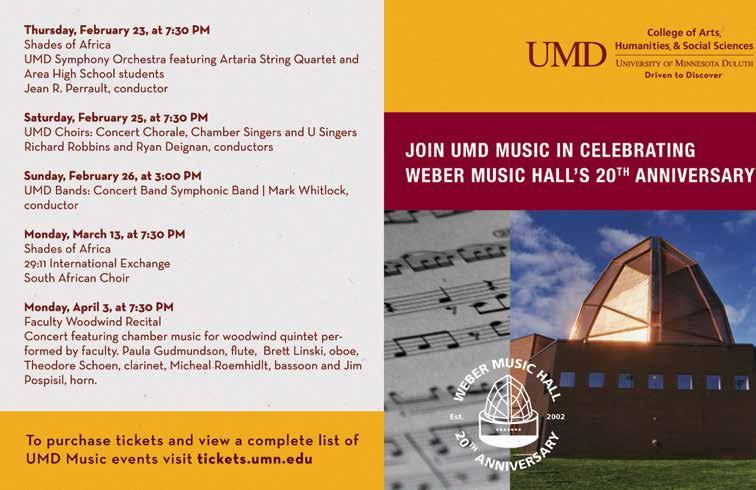
care happens here


Supporters of the Miller-Dwan Foundation see their gifts touch lives beyond hospital walls. Here, the youngest to the oldest in our area are cared for with dignity and respect. Our caregivers work wonders. And families find dignity, hope, and healing. We exist to support our region’s health. | mdfoundation.org
CSS FINE ARTS DEPARTMENT PRESENTS: LIVE IN PERSON MUSIC AND THEATRE FOR THE 2022-2023 ACADEMIC



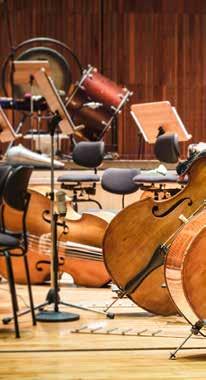
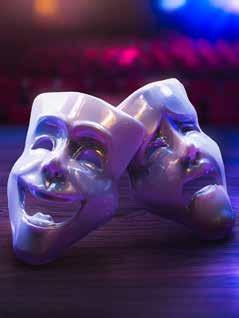

GO.CSS.EDU/SHOWS
CALENDAR
AND TICKETS. C: 0 M: 42 Y: 100 K: 20 M: 70 Y: 100 K: 44 C: 0 M: 10 Y: 100 K: 0 C: 25 M: 0 Y: 100 K: 0 C: 30 M: 56 Y: 100 K: 37 C: 0 M: 40 Y: 100 K: 10 C: 33 M: 55 Y: 97 K: 0 C: 0 M: 40 Y: 81 K: 66 Miller-Dwan Foundation Brand Guide 4 of 6
VISIT
FOR A
OF EVENTS


55 DULUTH SUPERIOR SYMPHONY ORCHESTRA 7
56 DULUTH SUPERIOR SYMPHONY ORCHESTRA 6





























































































































